|
|
Please note:
-
The video above shows Part 1 of the ModernTableGamer’s "How to play" tutorial. Click the corresponding link in the list of links below
to watch Part 2 on BoardGameGeek. Also note that these video tutorials are based on the first edition of Pax Porfiriana.
-
The Second Edition (a.k.a. Collector’s Edition) is for 1 to 6 players whereas on Yucata the maximum number of players is 5 and solo
play is not available.
-
The rules on this page are not regularly updated and there is no guarantee that they are completely consistent with the
official living rules on GoogleDocs. Use the official link (see the list of links below) if you are interested in the latest version of the living rules, independently
of this implementation.
-
Don’t skip the Glossary. It is an integral part of the rules and required reading for anyone interested in learning this game.
-
The User Interface is explained in detail in the UI section at the bottom of this page.
There is also an FAQ section answering the most frequently asked questions about the implementation.
Rules changes on Yucata:
Grudge Pile:
The cards in a Grudge Pile are shown right-side up instead of upside-down.
External links
Pax Porfiriana Living Rules
Power and Empire in Mexico, 1898–1920
based on Lords of the Sierra Madre 
All Editions, Version: Jul 3, 2016
Copyright © 2015 Sierra Madre Games, reproduce for personal use only.
Contents
A. Pax Porfiriana, as she is played
Rules Summary By Paul-Michael Agapow and Michael Griffiths
Pax Porfiriana is Latin for “The Porfirian Peace”, the 33-year reign of dictator Porfirio Díaz, who ruled Mexico with an
iron hand until toppled by the 1910 Revolution.
You are a Hacendado (rich businessman) in the pre-revolutionary borderlands of the U.S. and Mexico. Your aim is to
accumulate sufficient backers and justification (Prestige) to seize power during one of the periodic regime changes
(Topples). To do this, you will build a tableau of Enterprises (businesses that earn income gold to spend on other
efforts), Partners (allies with useful powers or influence) and Troops (which can extort gold from enterprises or
protect them from extortion). You can also foment Unrest (to paralyze enterprises), perform Assassinations
(neutralizing partners), and capitalize upon Headlines (external and random events).
1. Number of Players
This game is for two to six players, but there is a special solitaire variant in Part L.
2. Winning the Game During A Topple
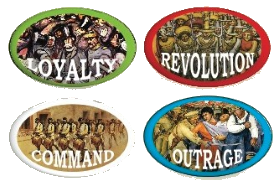
|
To win, accumulate enough Loyalty, Outrage, Command, or Revolution points to topple Díaz, either by succession,
Mexican annexation, coup, or popular revolt. The icons for these four types of Prestige Points are shown at the left.
If Díaz remains firmly seated at the fourth and final Topple, the player with the most gold disks is the winner.
During a Topple, only one of the four Prestige Points counts for victory, depending on the current governance of the
country. This is marked by one of four Regime Cards, which shows which tableau cards are in power at the moment,
which economic conditions hold, and what sort of Prestige is needed to topple Díaz — and win!
During a Topple, extra Prestige can be had by flipping your Hacendado. This represents your player declaring for one
of the two causes shown on the back of the card. But beware! Once you flip, your allegiance to this Prestige Point is
permanent.
|
3. Buying, Selling, and Speculating In the Market
On your turn you can do three Actions. One Action – “Buy Market Card” – buys a market card into your Hand. You can
take a second such Action, but it counts as two Actions.

|
The Market is laid out as two rows of six cards, with the two cards at the front of the Market costing 0 gold, the two in
the next column costing 1, and then 2, 4, 8, and 16. At the end of every turn, cards move forward to fill any cheaper
spaces with the market being restocked at the expensive end.
|
As an Action, any card in your hand may be sold to the discard pile for gold. The price is the Economy (gold) value as
listed in the current Regime.
Tip: If you’re short of gold, try buying a card for 0 gold and immediately selling it.
You can speculate on a market card by placing a cube of your color on it. Should anyone later buy that card, they will
pay you, not the bank. But you can’t speculate on a card that is already being speculated upon. And if you buy it
yourself, the bank gets paid.
Tip: If you don’t know what to do, speculating on a desirable card is always worthwhile. You might make gold, and you
might deter others from buying it.
4. Running an Enterprise: Income and Buying Land
You build an enterprise by the “Play Card” action. This costs the gold indicated and puts it into your Tableau.
Each enterprise has an Income, as listed in the card’s corner. These are of five types:

|
-
Fixed (unmarked cubes). These have an income equal to the number of cubes shown.
-
Improvable (cubes labelled “start income”). These also have an Income equal to the number of cubes shown, but
they can be improved later as described below.
-
Economy (cube and coin). These are usually banks, with an income equal to the Economy value of the current
Regime.
-
Mines (cube and gold bar). The income of these is equal to the mining value of the current Regime.
-
Projects (“X”). The Income of these depends on other enterprises, as specified.
|
When an Enterprise is played, place cubes on it equal to the current Income. Should the income later change (e.g.
because of Regime changes), adjust the number of cubes.
How can you extract even more gold out of an Enterprise? There are two ways:
-
Improve an Enterprise. The Buy Land action for an improvable Enterprise (ranch or plantation) takes 2 actions, costs
gold equal to the cubes already on the card, and adds a cube to the Enterprise’s Income. You may buy land multiple
times, although for a greater price each time due to the increasing number of cubes.
-
Improve Connection. If an Enterprise has a Connection icon (a boot, burro, train, or boat), you can perform the
“upgrade connection” action and pay to place a cube there. Building this not only earns income, but now Troops
being deployed to the Enterprise can (and must!) use the new and improved Connection.

Tip: You can build Connections to other players’ Enterprises, thus making gold and making it easier for you (or
anyone!) to deploy Troops there.
5. Ruining an Enterprise: Troops and Unrest
Your opponent’s enterprise is making a lot of gold. Time to wreck it! You can do this by playing troops or Unrest (red
disks) on its Tableau card.

|
You must pay to transport troops. The cost of this is listed on the troop card depending on the Connection used to
get there (boot, mule, train). Once there, the troop extorts the business by swapping one of its Income Cubes with
one of your color. Thus, income is diverted from the owner of the enterprise to you.
Tip: You can defensively deploy a troop to your own enterprise.
Naturally, you don’t extort gold from yourself.
|

|
The Unrest effect on certain cards stirs the workers at a targeted enterprise to rebellion. The card lists how many
Unrest (red) disks are placed on the business and how much gold is stolen from its owner.
|
6. Partners and Killing Them
You may play a partner card into your Tableau by paying its listed cost. These allies bring a variety of abilities,
especially reduced purchase prices for some Market cards.
Dispatch troublesome partners by playing an Assassination against them. But beware, the victim is awarded the
Prestige Point listed on the assassin. For instance, using the secret police to assassinate gives the victimized player
martyrdom prestige with the rebels. If you use the secret police to assassinate your own partner, you give yourself
this Prestige!
7. Jurisdiction

|
Troops and enterprises normally have a Jurisdiction. There are three of these: one in the US and two in Mexico
(Chihuahua and Sonora). This impacts gameplay in two ways:
-
Several cards have effects that target enterprises only in particular Jurisdictions (e.g. “nationalize a Mexican
enterprise”, “income equal to Chihuahuan mines”).
-
Troops can only be deployed to enterprises in their Jurisdiction.
|
8. Headlines, Factions, and Strife
|
|
Buying a Headline can spin world events to your own advantage.
Note that Headlines work differently to other deck cards:
-
Buying a Headline and playing it is a single Action.
-
Headlines usually have two Orientations as to how they are played.
The purchaser chooses which happens: “event” or “status quo”.
-
Should a Headline reach the end of the Market, i.e. be in the 0 cost column, it is discarded without effect in the
“discard headline” phase.
-
The four Topples are Headlines. Look out for them!
Many Headlines impact cooperation between Factions, the four allegiances that troops, partners, and even flipped
Hacendados belong to. They come in 4 colors:
-
Blue for US forces and interests
-
Green for Mexican federal authorities
-
White for local Mexican forces
-
Red for rebel groups
|

|
A Headline with the fist icon indicates Strife between the two Factions of the colors shown. All players with both
Factions in their Tableau must discard all cards of one of the Factions.
Tip: Triggering Strife between the right Factions can break up your opponent’s Tableau.
|
9. The Economy and Depressions
Bank earnings and the sale price of hand cards are equal to the Economy. The earnings of mines is equal to the
Mine
Value
. These two gold values are listed on the current Regime.

|
These are further modified by a Depression. All Headlines (including Topples) are discarded to a dedicated pile.
Should two consecutive cards with the “red bear” icon appear in this pile, the economy and mine value plunge to zero
in a Depression. Furthermore, during the “income phase”, each player must pay one gold for each card in their
Tableau except their Hacendado. Ouch. Fortunately, the economy revives if two bulls are played in a row.
Tip: You can trigger a Depression by buying the right Headlines in the right order. Useful if your opponent is into mines
and banking while you earn from ranches and plantations.
|
10. Last Words
See the main rules and glossary for details on Jail, Spies, Monopolies, Private Armies, Redeploying and Retreating
Troops, Assassinating players, and much more ...
B. Components & Card Anatomies
|
Regime Card
Enterprise Card
Partner Card
Troop Card
Black Card
Orange Card
Headline Card
Topple Card
|
1 Rules Manual
-
Golden Rule. If the text on a card contradicts these rules, the card has precedence.
-
Glossary. Terms in Capital Letters are defined in the glossary at the end of this manual.
These core definitions are essential for playing Pax Porfiriana.
220 Cards (only about 1/3 will be used per game)
1 Play Aid Card (white, double-sided)
6 Hacendado Cards (double-sided) are not in the Play Deck, but are rather used to identify who you are and your starting ability and
Income Cubes. See image on Page 6. The starting side is “loyalist”, and you may flip it over to either Orientation of its
“partner” side during a Toppling or Retreat.
4 Regime Cards (double-sided) are also not in the Play Deck, but are used to identify what kind of Regime governs the three
Districts, including the Economy and Mine Values. During a Topple, the Regime determines which Prestige Points are used for
victory. See Part H.
58 Enterprise Cards (tan) represent business infrastructures such as banks, mines, and ranches owned by players. They provide
Income and special abilities, see Part F.
-
Enterprises are vulnerable to Unrest and Extorting Troops.
-
Each enterprise has a flag showing its District location and a rail, mule, or boot icon in a square indicating its base Connection.
-
Some enterprises have one or two Connection Ovals and a price to upgrade that Connection.
-
Some enterprises include a Prestige Point in the upper right corner.
42 Partner Cards [in 4 Faction Colors: blue (U.S), green (federal), red (rebel) and white (local)] are specialists with whom you
have an arrangement.
-
Once played into your Tableau, Partners provide special abilities or Prestige. Some provide a bonus action. Some provide a
discount to purchase enterprises, however each enterprise can be discounted by only one partner (or by your Hacendado
starting ability).
-
Public Cards. Two of the Partner Cards are double-sided. Called Public Cards, they are not in the Play Deck or Market, but are
instead purchased by the “buy public card action” (E3).
30 Troop Cards (in 4 Faction Colors) are military forces deployed to “protect” enterprises, either yours or an
opponent’s. They can also be part of your Private Army.
-
Jurisdiction. The flag indicates where a troop can go.
-
Cost. The cost in gold to play a troop, or to Redeploy it after it has been played, is listed on its card depending the mode of
transport used to travel to the destination enterprise: rail, mule, or foot (G1).
-
Firepower. The strength in battle (G1) is indicated by the bow, rifle, or machine gun shown in the
card’s corner.
23 Black Cards are one-time defamations, lawsuits, Assassinations, or other dirty-dealings played against other players (or
against yourself, see Part J).
-
Limits. If the black card specifies a process, you CANNOT play it unless you can perform the process (e.g. the card says to
remove an opponent’s cube and he has none to remove).
-
Black cards expend 2 Actions to play unless played in the Regime specified.
-
Victim-Award. If a black or orange card depicts an upside-down Prestige Point, it is Victim-Awarded after playing. Your victim
stores the card as a victory point in his Grudge Pile, and if specified is put in Jail.
-
Robbery. Orange or black cards often steal gold as indicated in the gold peso icon. If a victim has insufficient gold, you are
allowed to steal everything he has.
23 Orange Cards are played against enterprises, even if they are protected by troops, stealing gold from the owner and placing
Unrest (red disks) representing bandits, Indians, strikers, etc. A few cause a Regime Change.
-
Jurisdiction. An orange card with a flag may only be played against an enterprise located in that District.
-
Like black cards, an orange card is one-use, requires you to perform the process specified on the card, and sometimes puts
your victim in Jail or steals his gold. It is usually Victim-Awarded after playing.
-
Orange and black cards can target an enterprise even if it is defended by troops.
-
Straw Man. You can play an orange card against one of your own enterprises, if it has no Unrest. See Part J.
29 Headline Cards (light yellow) indicate impending events impacting all players. If purchased, they are played immediately as
a single action.
-
Orientation. Headlines have two Orientations: an “event” side and a “status quo” side. Upon purchase, you choose a side. If
you play the event side, the listed effects are applied in the order listed on the card and impact all players, starting with the
player to your left. This usually includes Strife and a Regime Change (see glossary).
If you play the status quo side, there are no effects.
-
After playing, discard a Headline face-up into the Bull-Bear Discards. This can start or end a Depression
(Part I).
4 Topple Cards (yellow) are a special type of Headline Card representing one of four opportunities to dethrone President Díaz
and instantly win the game. Buying a Topple initiates a toppling, either modified or unmodified as chosen by the purchaser. If
purchased, see Part K.
1 Double-Sided “Pax P” Board
The Pax Porfiriana side is used to keep the play area organized. It has slots for the Public Cards, Market, Draw Deck, Regime,
and the two discard piles.
The other side is for Pax Pamir, another game in the “Pax” series. It is therefore NOT used for this game!
Pax Pamir, set in 19th century Afghanistan, is sold separately, available at
www.sierra-madre-games.eu  . .
60 Disks (used for gold)
90 Cubes
(for Income, Prestige, Connection, Extortion, & Speculation)
-
15 each in red, yellow, blue, green, white, and black
|
C. Setup
|
Hacendado Card
(loyalist side)
ALTERNATE RAPID SET UP:
-
Remove the 13 double-sided cards and the 4 Topple Cards, and shuffle the remaining 203-card Play Deck.
-
Remove 12 random cards to be used to build the Market.
-
Remove approximately half the remaining cards (they won’t be used).
-
Shuffle in the 4 Topples.
-
Prepare the Market, Public Cards and Hacendados per C3 through C11.
|
-
Separate the 13 double-sided cards from the others. These are Play Aid (1), Hacendado (6), Regime (4), and Public Cards (2).
-
With the remaining 207 cards build the Play Deck:
-
Remove the four Topple Cards for now.
-
Count 50 cards plus 10 cards per player in the game.
-
Shuffle these cards and create six stacks of about the same size.
-
Shuffle one Topple each into four of the six stacks.
-
Put the six stacks on top of each other, with the two stacks without a Topple being uppermost.
-
From the top of the Play Deck lay out 12 face-up cards in two rows of six each to the left of your Play Deck – this
is the Market.
-
Place the two Public Cards (Catholic Church [214] and Teddy Roosevelt [215]) in the two angled spaces on the right side of
the board.
-
Place the four Regime Cards in the slot in the lower right corner of the board.
-
Shuffle the six Hacendado Cards and deal one to each player. Alternately, if everyone agrees, players can choose their
favorites.
-
The remaining cards go back into the box, as they won’t be used in this game.
-
Each player gets 15 cubes of any available color.
-
Randomly determine a starting player.
-
The starting player receives four gold, the second player in order five gold, the third player six and so on.
-
The starting player begins the first turn by performing his three actions.
|
D. Sequence of Play
Each player performs these four phases, and then play passes to the next player to the left.
-
Your Hand is kept secret, but all gold, Tableau cards, and cards in Grudge Piles are open for opponents to examine.
1. Action Phase
Perform up to three Actions; see Part E.
-
If a Topple Card is purchased, see Part K.
-
If you are in Jail, you only get two Actions.
2. Discard Headlines
Discard without effect any Headlines in the zero-cost column in the Market. Headlines are cards with bull
or a bear icons in their corners, including Topples. Discarded Headlines go face-up into the Bull-Bear Discards.
-
If both zero-cost columns are occupied by Headlines, the player whose turn it is decides the order in which they are
discarded.
-
Discarding a bear card on top of another bear card initiates a Depression (Part I). They do not have to be discarded on the same
turn, e.g. a bear card could have been previously placed there. Place a red disk on the Regime Card to indicate the
Depression.
-
Discarding a bull card on top of another bull card ends a Depression.
3. Restore Market
Restore the market to 12-cards by sliding cards towards the zero-cost slots along their respective rows to
fill the market slots left empty by player purchases or discards. Then one-by-one, flip fresh cards to fill the newly created empty
slots, starting with the cheaper slots.
4. Income Phase
Collect one gold for each cube of your color on an In Play card. Do not collect for Speculation Cubes or for
cubes on enterprises suffering any Unrest. Do not forget to collect for Extortion and Connection Cubes that are in the Tableaus
of other players. See Part F.
-
During a Depression, pay one gold for each card In Play (i.e. your own troops, partners and enterprises, but not your
Hacendado or cards in your Grudge Pile). Discard any In Play Card that you can’t, or choose not to, pay for.
Example: When Depression hits, you have a partner, a ranch, and a mine in your Tableau. On your income phase, you collect
income from your ranch, but not your mine, since the Mine Value is now zero. Since the ranch is still making money, you decide
to pay one gold to keep it afloat. But the partner and the mine are dead losses, and you decide to discard them rather than pay
for them.
Deal-Making:
You may never transfer cards or money; but other than that, you can make any deal during the game. Deals extending into
future turns are non-binding; after all, everybody wants to become the next dictator-for-life.
E. Actions
During your turn, you may expend up to three Actions, in any order, from this list:
1. Play Card Action
Play a card from your Hand and pay the cost of gold listed in the top right corner. Any effects listed on a card take effect
immediately after playing it.
-
An Orange Card is played against an enterprise (including yours). Place as many Unrest Disks as indicated in the red icon and
steal from the victim up to amount of gold indicated in the gold peso icon. If the victim does not have enough gold, you must
steal as much as he has. An orange card with a District flag cannot target enterprises outside that District (not even during
Anarchy). Both orange and black cards can target an enterprise even if it is defended by troops. Once played, an orange and
black card must be Victim-Awarded if it has a Prestige, or discarded otherwise. Remember that you can be the victim of your own
attacks (Part J).
-
A Black Card is played against an opponent (or yourself, see Part J). Unless played during the Regime depicted, this play
expends two Actions instead of one. Like the orange card play, a black card play steals from the victim up to the amount of
gold indicated, then is awarded to the victim (or discarded if it has no Prestige).
Example: “Steal 4” means steal as much as that victim can pay, up to 4 gold.
-
An Enterprise or Partner Card is played in your Tableau. If it has a Loyalty icon, during the Pax Regime put a Prestige Cube on
the icon. If it’s an enterprise, place a number of Income Cubes on it depending on the icon in the upper left corner (see
legend to the left).
-
A Troop Card must be played to a destination, which can be an existing enterprise (G1) or a flipped Hacendado (G3). You
must meet the requirements to enter the destination (G1). The cost to play a troop is listed in its lower row according to the
Connection of the destination (G1). Place the troop half-under its destination card, and implement its listed effects (Regime
Change, Unrest, Slave Revolts, etc., see glossary). If played as an Extorting Troop (G4), place an Extortion Cube on it.
2. Buy Market Card Action
Purchase one of the revealed cards on the Market. You may only perform this Action twice per turn, and buying a second card
from the Market expends two Actions. The gold cost of the card is listed on the board above the Market column the card is
located in (0, 1, 2, 4, 8, 16). Removing the purchased card leaves a gap, which is not refilled until the “restore market” phase
(D3).
-
Hand Limit: Except for Headlines, purchased cards go into your Hand. Your Hand Limit is 5 Cards. If at your limit, you cannot
buy new cards into your Hand, but you can buy Play-Immediately Cards (Headlines and Public Cards).
-
Play Headlines immediately after purchase. When playing a Headline (including Topples), choose an Orientation: “event” or
“status quo”. If you choose “event”, the listed effects immediately impact all players, starting with the player to the left of
the purchaser and going clockwise ending with the purchaser. Then discard the card into the Bull-Bear Discards.
-
Headline Effects include Strife, Regime Change, Depression, and other events. See the glossary.
-
Topple Cards are special Headlines. When purchased, they initiate a Toppling, pausing the game. See Part K.
3. Buy Public Card Action
Purchase and put into play one of the two Public Cards, which are separate from the Market.
-
Cost. A Public Card is bought at the price indicated in its top right corner.
-
A Public Card is a Play-Immediately Card and never goes to your Hand. You may buy a Public Card even if at your Hand Limit
(5-cards).
-
This Action both purchases the Public Card and plays it into your Tableau, and is independent of how many Market Cards you
have purchased that turn.
-
You may play a Public Card into your Tableau on either its front or rear side.
-
The play of a Public Card may cause Strife or a Regime Change, see glossary.
4. Sell Card Action
Discard a card and take gold from the pool equal to the Economy, a gold value listed on the current Regime. You may sell a card
from your Hand or In Play.
5. Redeploy Troop Action
Move your troop from one destination to another for the Connection-dependent cost listed on its card. You must meet the
requirements to enter the destination (G1).
-
Alternately, redeploy in place for no cost or requirements (G0).
-
Redeploy (and Redeploy in place) removes a number of Unrest equal to the troop’s Firepower.
6. Buy Land Action
Expend two actions to add one Income Cube to your ranch or plantation. The cost in gold is the number of cubes already on the
ranch or plantation (no matter the type of cubes or owner).
Example: A plantation enterprise has an Income Cube, a Connection Cube, and an Extortion Cube. It costs 2 Actions and 3 Gold
to buy land for a second Income Cube.
7. Upgrade Connection Action
Place a cube on any empty Connection oval on an In Play enterprise (even an opponent’s). This cube, called a Connection Cube,
represents both an income source and an upgrade for troop deployment (e.g. from mulepack to a railroad, see G1 and the
diagram at left).
-
Limit. There is a limit of one Connection Cube per Connection oval.
-
Upgrade. A Connection Cube upgrades and replaces the base Connection (indicated in the bottom of the card). However,
during Unrest the upgrade is shut down and the base Connection must be used.
-
Cost. Pay the gold shown in the Connection oval.
-
Chain Rail. A Connection oval depicting a gold chain is a Chain Railroad. Upgrading to a Chain Railroad confers special
advantages, see glossary. One of these advantages is being able to upgrade subsequent Connections of any sort for only one
gold instead of the listed price. However, all these advantages are shut down if the Chain Railroad is in Unrest.
8. Police Action
Spend three gold to remove an Unrest from one of your enterprises, or zero gold if the enterprise has troops present,
regardless who owns the troops.
-
Jail. You may instead expend a police action to spend three gold to get out of Jail. Getting out of Jail immediately restores
your third Action for the turn.
-
Martial Law. During the Martial Law regime, all police actions cost zero instead of three gold.
9. Speculation Action
Place one of your cubes, called a Speculation Cube, on any card in the Market that does not already contain a Speculation Cube.
If an opponent buys a card with your Speculation Cube on it, whatever he spends for the card is given to you instead of to the
pool.
Example: Reyes buys a card with your Speculation Cube for 16-gold, and pays you the 16-gold. But if he has a special ability to
buy the card for zero, your speculation gets nothing. In either case, the cube is returned to you.
-
Every card in the Market may only have one Speculation Cube.
-
Any Market card can be speculated, including Headlines and Topples, with the exception of the fourth and final Topple Card.
-
The Speculation Cube is returned to your reserves if the card is purchased or discarded.
-
Speculation Cubes do not earn income.
-
Portfolio Management. As a “speculation action”, you can move your own Speculation Cube from one card to another in the Market.
-
Cube Management. You are limited to the 15 cubes provided. If you are out of cubes, as a “speculation action” you can shift
one Income, Connection, Prestige, or Speculation Cube (but not an Extortion Cube) of yours from one valid location to
another (including back to your reserves).
-
Income Cube Management. You can also use the “speculation action” to add a cube from your reserves to an enterprise that
currently has fewer Income Cubes than allowed under the current Regime. (e.g. a Bank with only two income during Pax, or a
smelter without income even though it is hooked up to a mine, because you ran out of cubes).
-
Income Cube Management Limitations. Ranches and plantations can never increase Income Cubes except by the “buy land
action” (and certain Headlines), and Connections cannot gain cubes except by the “upgrade connection action” (E7).
-
Prestige Cube Management. You may add Prestige Cubes to Prestige Points that need it without using an Action.
Example (see diagram): Player Blue has used all his cubes. He uses a speculation action to shift a Connection Cube from one
enterprise suffering from Unrest, to a bank enterprise that is allowed additional Income Cubes (because the Regime is Pax). Any
player can rebuild the abandoned Connection.
Example (Slave Revolt): In the previous example, the enterprise suffering Unrest is the notorious slave mine “Minas Prietas”
[061]. Removing its Connection Cube ignites a Slave Revolt (see glossary), since the number of cubes is now less than its Unrest.
This shuts down the mine, and its card is added to the Grudge Pile of Player Blue, since he is the Liberator. However, he is also
Jailed, no doubt for his negligence in allowing the slaves to revolt.
F. Earning Gold
|
Regime
Gun Store
Smelter
|
Income is earned during the “income phase” (D4) according to the number of cubes of your color currently In Play. You earn
one gold for each of your Connection Cubes, Extortion Cubes, and Income Cubes. Any cubes on an enterprise in Unrest do not
earn income.
-
Hacendado. As long as you pretend to be a pro-Díaz loyalist, your Hacendado maintains two Income Cubes on its card. Once
you flip your card to its “partner” side, you lose this personal income.
-
Ranches start with one Income Cube, but can grow using the “buy land action” (E6).
-
Plantations can be expanded like ranches, but are vulnerable to Slave Revolts, as detailed in the glossary. (Enslavement of
Yaqui Indians was still legal in Sonora.)
-
Mines have Income Cubes set by the Mine Value, as set by the current Regime. For instance, during the “Pax Porfiriana”
Regime all mines have two Income Cubes. Immediately adjust the number of cubes whenever the Regime Changes, or if
Depression hits (E1).
-
Banks have Income Cubes equal to the Economy, as set by the current Regime. Immediately adjust this whenever the Regime
Changes, or if Depression hits (E1).
-
Gun Stores have one Income Cube plus a cheap Connection. As listed on the card, if you own a gun store, each time any
player (including yourself) plays an orange card, you receive 2 gold from the pool. If there are multiple gun stores, each
owner receives exactly 2 gold, regardless how many gun stores he owns. He receives this gold even if his gun store itself is
shut down in the orange card attack. See the example in Part J.
-
Connection Upgrades are built by buying a Connection Cube, as detailed in E7. This cube earns income and is immune from
Extorting Troops. Connections can be built by any player, so watch for opportunities to build your opponent’s Connections.
-
Smelters and Projects have a number of Income Cubes which can vary throughout the game, depending on how many
enterprises of the specified type (without Unrest) are built (by any player). Smelters and projects also provide the Loyalty
Prestige Point indicated.
-
An Extorting Troop doesn’t so much earn income as requisition (or plain steal) one income from the opponent’s enterprise
where it is based. This is indicated by changing the color of one of the enterprise’s Income Cubes (G4). If an enterprise’s
Income is reduced to the point that its Extortion Cube is removed, the enterprise is Sacked.
-
Kickbacks. During the “Pax Porfiriana” Regime, each Loyalty Point is given a Prestige Cube, representing kickbacks by
President Díaz. This earns income like Income Cubes, but is removed every time the Regime changes to anything other than
Pax (see Part H).
You can earn gold outside of your “income phase”:
-
During Your Action Phase, gain instant cash by selling cards, playing certain Headlines or using orange/black cards to steal
from opponents.
-
During Your Opponent’s Turn, you can gain gold using Monopolies, gun stores, Speculation Cubes, or thanks to the event side
of certain Headlines.
|
G. Play or Redeploy Troops
As an Action, you may play a troop from your Hand, or Redeploy a troop of yours already In Play. The destination may
be your enterprise (G2), your flipped Hacendado (G3), or an opponent’s enterprise
(G4).
-
Effects When First Played. Playing a troop from your Hand activates the effects listed on its card (e.g. Regime
Change, adding Unrest to every enterprise in the District other than the destination, etc.), but redeploying or
Retreating it does not.
-
Redeploy In Place. You may expend a “redeploy troop action” (E5) to activate a troop of yours without moving it.
This costs no gold, and removes a number of Unrest equal to the Firepower of the troop.
-
If leaving an enterprise you are extorting, convert the Extortion Cube back into the color of the player who owns the
enterprise.
1. Requirements to Occupy an Enterprise
-
The destination enterprise must be in the troop’s Jurisdiction, see glossary. Exceptions: U.S. intervention, Anarchy,
and Chain Railroads.
-
Battle. Each enterprise can only be occupied by one troop. If the destination enterprise is occupied with a troop
(regardless of ownership), your troop must have greater Firepower (the number of dots in the upper left corner,
see glossary). This defeats and discards the defender.
-
Optional “Retirement” Battle Rule. If you have flipped your Hacendado, whenever one of your troops belonging to
your Hacendado’s Faction is defeated by forces of the same Faction (e.g. a battle where white is defeated by
white), you may Retreat your troop instead of discarding it per the previous bullet. What is happening is not a
battle (since troops of the same Faction don’t fight). Instead the superior Firepower is “relieving” a force of lesser
Firepower, who “retire” to their home base.
-
Costs. Pay the amount of gold listed on the troop card depending upon the destination’s Connection-type (boot,
mule, or rail). An upgrade changes this Connection unless in Unrest.
Example (play troop, see diagram): To protect Minas Prietas [061], a Sonoran mine you own, you play your Indian
Fighters [184] (a local Sonoran troop) to this location. The mine has its rail connection built, so the troops must use
the train to travel there. The rail cost for the Indian Fighters is 1 gold, so you pay 1 gold to play its card. The Indian
Fighters have two effects when played: a Regime Change to Martial Law, and placing one Unrest on every other
enterprise in Sonora.
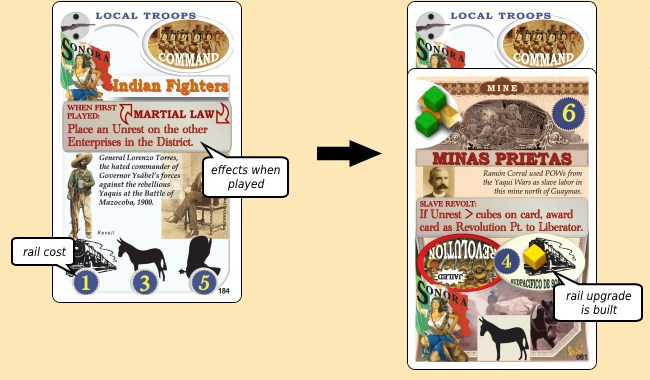
2. The Destination is Your Enterprise
follow these 5 steps:
-
Battle. If the destination has a troop, your troop must have greater Firepower (G1).
-
Unrest. If the destination has Unrest, remove a number of disks equal to your troop’s Firepower.
-
No Sacking. A troop at your own enterprise and will not Sack it, even if it has no income.
-
Place your troop half-under the destination.
-
You do not need an Extortion Cube for your own troops at your own Enterprise.
Example (unrest): In the previous example, Minas Prieta has 2 Unrest disks. Since the rail is shut down, to play your
troop there you must use the mine’s base connection (mule road) instead. The Indian Fighters use the mule road for a
cost of 3 gold. Since they have a Firepower of two dots, upon arrival they remove both red disks.
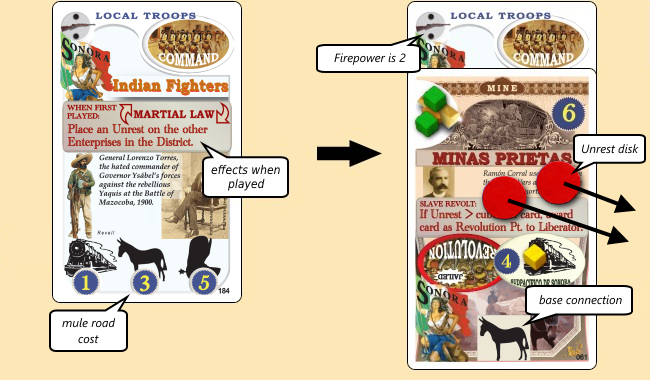
3. The Destination is Your Flipped Hacendado
Place your troop half-under the Hacendado.
-
The Connection to travel to the Hacendado is marked on its card (see illustration).
-
The troop must be the same color as the Prestige Point of the flipped Hacendado. It becomes a Private Army, see
glossary.
-
You cannot move to or extort an enemy Hacendado.
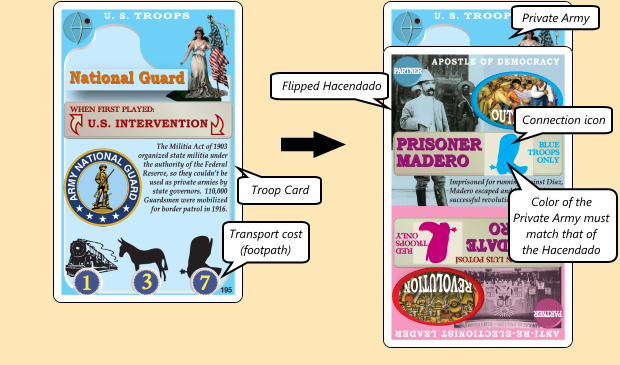
4. The Destination is Your Opponent’s Enterprise
Follow these 5 steps:
-
Battle. You must have a cube in reserves to act as an Extortion Cube. If the destination has a troop, your troop
must have greater Firepower per G1 above.
-
Unrest. If the destination has Unrest, you must remove a number of disks equal to your troop’s Firepower.
-
Sacking. If the destination is an enterprise with no Income or Extortion cubes, it is Sacked (i.e. returned to your hand, see
glossary).
-
Place your troop half-under the destination, so its Firepower and Prestige Point (if any) are visible.
-
Remove one of the destination’s Income Cubes (or the Extortion Cube of the previous extorter if present), and
replace it with an Extortion Cube of your color. Place the Extortion Cube on the extorting troop card, indicating that
the troop is an Extorting Troop in your employ, and earns income for you.
Example (battle): In the previous example, Minas Prieta is an opponent’s enterprise, and it is occupied by one of his
troops with a Firepower of 2. Your Indian Fighters also have this Firepower, and so cannot be played there. But if you
have a general increasing your Firepower to 3, you defeat and discard the defenders.
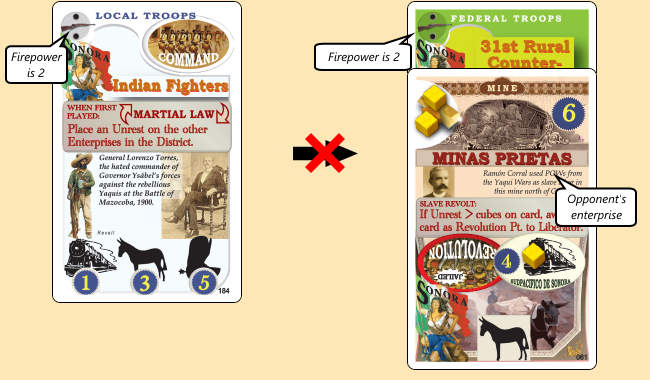
5. If Your Enterprise Is Extorted.
|
Extorted Enterprise
|
-
The presence of an Extorting Troop allows you to remove one Unrest as a zero-cost “police action” (E8), even if the
troop is not yours.
-
If during the game your extorted enterprise loses income (e.g. Depression or Regime Change), remove the Income
Cubes first, and the Extortion Cube last. If the Extortion Cube is removed, the enterprise is Sacked, see glossary.
Example (sacking): You own Minas Prieta, a mine being extorted by rebels. A Depression strikes, which plunges the
mining income to zero and removes all its Income and Extortion Cubes. The mine is Sacked, and its card goes to your
Hand. The Extorting Troop retreats to its owner’s Private Army.
|
H. REGIMES
|
|
The four Regime Cards depicting the four types of governance are:
1. Pax Porfiriana (Mines = 2, Economy = 3)
The Latin for “Porfiriana’s Peace”, referring to Porfirio Díaz, the dictator firmly in control.
Abbreviated “Pax”.
2. U.S. Intervention (Mines = 3, Economy = 2)
American forces are occupying northern Mexico.
3. Martial Law (Mines = 2, Economy = 2)
Northern Mexico is under a local military regime, independent from Mexico City.
4. Anarchy (Mines = 1, Economy = 1)
Anarchists opposed to property rights have seized control. Or perhaps nobody is in control and the government is
reduced to local gangs.
5. Regime Change
The starting Regime is “Pax Porfiriana”, but this changes instantly if a card with the swirl-arrow
icons is played (i.e. certain Headline, Troop, Orange, or Public Cards). Indicate the Regime Change by placing the
new Regime face-up on top of its stack.
-
All players adjust the “profit” on each bank to equal the new Economy, and on each mine to equal the new Mine
Value. The “profit” is the sum of the number of Income and Extortion Cubes on the enterprise, see G5.
-
If the Regime changes to Pax, each player adds one Prestige Cube to each Loyalty Prestige he has In Play. Remove them if the
Regime changes away from Pax.
-
When adding cubes, players are limited to the 15 cubes provided.
|
I. Depression

|
Once a second “bear” card in a row is discarded in the Bull-Bear Discards, place a disk in the “red bear” spot on the
current Regime Card. This disk signals an economic Depression, persisting even if the Regime Changes.
|
1. Mines and Banks
The “Mine” and “Economy” values are zero during a Depression, so remove all Income and
Extortion Cubes from mines and banks, leaving only their Connection and Prestige Cubes, if any.
-
Even mines improved by patents fall to zero value.
-
Sack. If an extorted enterprise now has no Income or Extortion Cubes, it is immediately Sacked (see glossary).
Remember that your troops in your own Tableau never Sack.
2. Depression Expenses
During a Depression, after drawing income during your “income phase” (D4), pay one gold
for each card you have In Play, including enterprises, partners, and troops (both Extorting Troops and Private Armies).
Do not pay for your Hacendado Card or Grudge Cards.
3. End of a Depression

|
If two cards in a row with the bull icon are discarded into the Bull-Bear Discards, then the Depression ends instantly and its disk is
removed from the Regime Card. Mine and bank Income Cubes are adjusted as stated in Regime Change (glossary).
|
J. The Straw Man
|
Orange Card
Slave Plantation
|
As a rather Machiavellian tactic, you may play an orange or black card against one of your own enterprises or partners.
Welcome to Mexico! This is called a Straw Man play.
Why play a card against yourself?
If you are the victim of your own orange or black card play, you suffer the attack but receive
the Victim-Awarded Prestige Point into your Grudge Pile. For instance, assassinating your own partner gives you the Outrage
Point on the Assassination Card.
Limitations
-
You cannot play an orange card against one of your own enterprises that already has Unrest Disks.
-
You cannot play against yourself a black or orange card that specifies use against an opponent (e.g. conspiracies and
antitrust).
-
Stealing gold from yourself has no effect.
-
Scapegoat Plays. Certain orange cards (e.g. strikes) can sometimes be played for zero cost to inflict zero Unrest. This play
nevertheless still awards the card to your Grudge Pile.
Example: You have 3 Revolution Prestige and own a slave plantation and a gun store. On your turn, you play Wobblies [005]
against your own slave plantation, stealing 3 gold (which is ignored, since you are stealing from yourself) and generating 3
Unrest, enough for a Slave Revolt (see glossary). You lose the plantation, but on the other hand you gain 2 gold because of the
gun store’s bonus, and gain both the Outrage on the orange card plus the Revolution on the plantation (for being the Liberator).
It’s as if you say, “What a great revolutionary I am, freeing the oppressed”, omitting the fact that you were also the oppressor.
|
K. Toppling Díaz for the Win
If you buy a Topple, you must immediately interrupt the game to initiate a toppling. The type of toppling is
determined by the Regime at the instant of purchase. That is, if there is Martial Law the topple is by Coup D’état, if
there is Pax the topple is by retirement, if there is Anarchy the topple is by Free Elections, and if there is U.S.
intervention the topple is by annexation. If Díaz is successfully deposed, somebody wins the game. Follow these
steps:
1. Topple Orientation
|
Topple
|
Just as for the other Headlines, each of the four Topples has two Orientations: either “event”
or “status quo”. The purchaser chooses which Orientation to play.
-
Achilles Heel. Each of the four Topples lists a different “Achilles Heel” on its “event” Orientation, i.e. a
Regime-specific opportunity to topple Díaz. For instance, the “Presidente Díaz Is Shot” Topple indicates that Díaz is
particularly vulnerable to a Coup if played on its “event” side, reflected by subtracting one from his Command
Value that he uses to defend against Topples. But if played on its “status quo” side, Díaz has no “Achilles Heel” and
defends unmodified in K3. In both cases, the Topple proceeds regardless of the Orientation chosen.
Example: You purchase the “Presidente Díaz Is Shot” Topple [206] during the “anarchy” Regime. One orientation
subtracts from the defensive Command of Díaz during a Coup, the other does not. In this case, it does not matter
which Orientation you play the card, because the Regime is not Martial Law and thus Díaz is in no danger of falling by
Coup.
|
2. Topple Showdown
Starting with the player to the left of the player whose turn it is (who played the Topple) and
continuing clockwise to end with the player whose turn it is, each player makes the following three topple decisions:
-
Issue Manifesto. If their Hacendado is not yet flipped, they may flip it to its “partner” side to the Orientation of
their choice. The extra Prestige Point gained this way could make the difference between winning and losing.
-
Election Fraud. If they have any “During Toppling” cards (e.g. Spies, Courts) In Play, they may discard them. This
modifies the Díaz defense for ALL PLAYERS for this turn’s toppling attempt, including those who discarded the
cards.
-
Player Assassination. If they have any “Assassination” cards (i.e. any Black Card labeled “Assassination”) in their
hand, they may play one to assassinate any flipped Hacendado (even your own, simulating parricide). This flips your victim’s card permanently
back to its “Loyalist” side (representing his son or heir). He gets the Assassination as a Victim-Award. A Player Assassination
costs 3 gold, plus 3 gold for each troop in the victim’s Private Army.
Example: Your opponent purchases a Topple. When it is your turn in the showdown, you discard the Mexican Postal
Service [014] out of your Tableau, with the ability “Discard to +1 to Díaz Outrage, Command, Loyalty, or Revolution”.
This adds to the Díaz defense, making him harder to topple. Furthermore, you spend 3 gold and discard your “Ley de
Fuga” card [162] out of your Tableau and shoot your opponent’s flipped Hacendado.
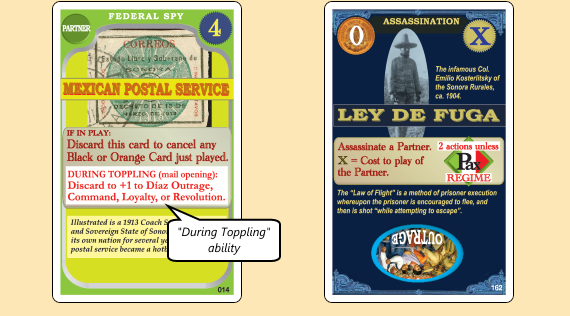
3. Toppling Success
After the showdown, each player separately determines whether he can topple Díaz, by
comparing his Prestige total to that of his Tripartite. To topple Díaz, you need more Prestige Points (Loyalty, Outrage,
Command, or Revolution, as specified by the Regime) than those held by your Tripartite. Your Tripartite consists of
Díaz with 2 Prestige Points, plus two of your opponents with the lowest Prestige Points specified by the Regime.
-
Two-player game. The Tripartite consists of President Díaz with 2 Prestige points, his Vice-President with 1 Prestige
point, plus the Prestige points of your opponent.
-
Iron Hand Variant (recommended for the 5-6 player game). For a longer, more gold-oriented game, have the
Tripartite consist of Díaz plus your two opponents with the highest Prestige Points of the type specified by the
Regime.
-
Díaz Senility Variant (recommended for the 3 player game). With experienced players, it is often difficult to topple
Díaz late in the game, especially with 3-players. Therefore, rather than a flat Díaz defense of 2 Prestige Points, give
him 3 on the 1st topple, 2 on the 2nd, 2 on the 3rd, and 1 on the last.
4. Determine The Winner
Win by toppling Díaz. If there are multiple topplers, then there is a Gold Victory among
them. If nobody is able to topple Díaz on the fourth Toppling, then there is a Gold Victory among all players when the
Topple is either played or discarded from the Market (D2).
Tip: The other side of each Regime Card indicates the Tripartite Defense and Prestige Points for a Topple during that
Regime.
Example: In a 4-player game, you purchase the “Presidente Díaz Is Shot” Topple [206] during Martial Law. You play it
on its “event” side, giving Díaz an Achilles Heel that subtracts one from his command. His defense is therefore 2 - 1 = 1.
Two of your opponents have no Command Points at all, so your Tripartite consists of 1 (Díaz) + 0 + 0 = 1. You have 2
Command Points and therefore successfully topple Díaz by Coup. But your strongest opponent has 3 Command Points,
so he also topples Díaz. But you have more gold than him, and win in a Gold Victory.
L. Solitaire Variant
Setup the solitaire game as per Part C for two players, but your opponent is Díaz himself. You will need a 6‐sided die.
You go first.
-
Díaz gets no gold, cubes, Hacendado Card, or hand cards, but he has 6 Outrage points and 4 of every other kind of
Prestige Point. These Prestige Points are effective for all purposes.
1. Díaz turn
On his turn, roll the die twice for Díaz, once for each row in the Market. Díaz always buys the two cards
indicated by the die‐roll, with the zero‐cost column corresponding to a “1” and the 16‐cost column corresponding to
“6”. He plays both cards per below, in the order purchased. He does not spend any gold for buying or playing.
-
If it is a Topple, Díaz discards it.
-
If it’s an enterprise with a Prestige icon (including plantations), Díaz plays it to his Tableau. He discards other
enterprises.
-
If it is a partner, Díaz plays it into his Tableau. If it has two Orientations (e.g. Newspapers), roll the die for the
Orientation. Díaz gains the abilities conferred by partners, such as generals giving extra Firepower for his troops.
-
If it is a Headline, Díaz plays it on its “event” Orientation it if it changes the Regime to Pax Porfiriana, otherwise he
discards it.
-
If it is a troop card that can extort an enterprise of yours, he does so, against the eligible enterprise with the most
cubes. Use a white cube to show the Díaz extortion, although he gets no income from this. If his troop cannot
extort, he deploys to one of his own enterprises if possible. Discard if not playable.
-
If it is an Orange or Black card, Díaz plays it against you to steal gold or inflict Unrest, if possible. If you have no valid
target, he plays it for strawman actions against his own partners/enterprises if possible. Discard if not playable.
-
If it is a card that can be discarded to increase the Díaz defense (K2), he does so.
-
Ties. If Díaz plays a card against an enterprise or partner, he chooses the eligible enterprise with the most cubes, or
the eligible partner with a Prestige Point that you have the most of. In case of further ties, he chooses the card free
of Unrest with the highest card number.
2. Special Rules
-
If a Headline at the zero‐cost column is discarded, it is played on its event Orientation if it changes the Regime to
Pax Porfiriana.
-
You may speculate on cards, and receive gold if Díaz buys them.
-
If Díaz is hit by Strife, roll the die to see which Faction Color he discards.
-
Díaz is immune to depression.
-
To win: Topple Díaz during one of the four Topplings. The Díaz Defense is four (6 if Outrage) plus the Prestige Points
of his In‐Play Cards and Grudge Pile.
M. The Pax-o-matic – A diceless solitaire variant for Pax Porfiriana
Courtesy Colin Taylor
Introduction & Set Up
The Pax-o-matic is a robot player that can be used to play a solo game of Pax Porfiriana.
The game is set up as a 3P game, using 2 Pax-o-matic opponents and one human player. The game follows all normal rules. Subsequent
sections detail out how to operate a Pax-o-matic through specific situations, such as a Topple or Depression. This
is followed by a series of decisions laid out in a flowchart, that the Pax-o-matic considers in order, and will direct
which actions it takes during its turn.
Depression
During a Depression, the Pax-o-matic will spend to retain cards equal to its income + 1/3 of its excess gold,
rounding down. However, it will always retain at least 1 card. Remove Partner cards first, then Troops, ascending
by Pax-o-matic cubes they protect.
Strife
When Strife is enacted, the Pax-o-matic will discard cards of the color it has the least of. If tied, it discards the
color whose Troops protect the least of its cubes.
Topple
-
If the Pax-o-matic can guarantee a win, it will make all moves to do so. The other will not assist in the win, but
will not play any cards to prevent it.
-
If no such win is guaranteed, but it is possible to guarantee the human player cannot win, it will make the
fewest number of moves necessary to do so. In this case, it is assumed that both Pax-o-matics will cooperate, if
necessary. If not all available options are required, it prefers to use them in the following order: Assassinate the
human Hacendado/Utilize Election Fraud/Issue Manifesto.
Flowchart Guidelines
-
For each Action, start at 1. and move down.
-
Unless expressly limited, the Pax-o-matic will carry out the first Action for which it is eligible. This includes
having sufficient gold to pay for the Action, if necessary.
-
Ties are usually broken per the flowchart instructions (in bullet point order, with nested bullets on occasion). If
none, break ties randomly.
Specific Card Instructions
-
“During Toppling” – Cards with a “During Toppling” effect are used as needed. Spy cards are ONLY used for
this effect, unless being stolen.
-
#34, 43 – Use first to place Unrest if there are any viable targets based on the priorities under “Play Card:
Orange/Black”. These Activist cards should not be used during Martial Law. Only play on unprotected
Enterprises. #43 can be used for Regime Change if the Pax-o-matic leads the human player in Revolution
Prestige points.
-
#40-41 – These Governor cards are only played if the human player discards more cards (both Enterprise and
Troop cards) than the Pax-o-matic.
-
Headline card effects – If a Headline card has an effect other than Strife, where a decision is made by the
Pax-o-matic, choose the least impactful option. For example, Nationalize the cheapest Enterprise (including any
Troop cost), place Unrest at the location that would be easiest to remove etc... The Pax-o-matic will also pay to
keep as many Enterprises as possible.
-
Public Cards – In the rare instance the Pax-o-matic wishes to buy a 16 Gold Market card, it will also consider
buying a Public card (even the 18 Gold cards).
Flowchart
-
Remove a Jail token
-
Remove Unrest token(s)
-
Where the most tokens would be removed (by use of Police Actions, Deploying or Redeploying Troops).
-
Buy 1st Market/Public card
Skip this Action if the 1st card has already been purchased. Otherwise, it buys the cheapest card that satisfies any
of the conditions stated below. If both cards of the same price are eligible, it buys in the order the conditions are
written. If still tied, it buys the card that is the cheapest to play. When the decision involves downstream
requirements, it assumes current tableaus would be in effect (e.g. to buy an Orange card to place Unrest tokens).
The presence of a human player speculation cube on a card prevents its purchase, unless the cost is 0. It can buy
a card with a Pax-o-matic speculation cube on it, transferring gold as necessary:
-
Topple
-
Headline
-
If the human player has to discard more cards to Strife than it does.
-
If the human player leads the Tripartite in the Prestige relevant to the current Regime, and not in the
Regime on the Headline, or the Pax-o-matic leads the Tripartite on the Headline Regime, and not in the
current Regime.
-
Troop
-
If they could remove any Extorting Troops.
-
If they could be played on any unprotected Enterprise in play.
-
If they could Extort any human player Enterprise, except Slave Revolt cards.
-
If they match the District of any Enterprise in its hand.
-
Partner
-
Enterprise
-
Orange/Black
-
Play A Card
Prioritize which cards to play, and where, using the following requirements:
-
Troop
-
Descending by Firepower.
-
To remove Extorting Troops.
-
To an unprotected Enterprise card with the highest Pax-o-matic cube count.
-
To Extort the human player, but never at a Slave Revolt card.
-
Partner
-
Matching the Prestige type that the human player is currently leading the Tripartite in.
-
Matching any Prestige type that the Pax-o-matic is beating the other Pax-o-matic in.
-
Matching any Prestige type of its Hacendado.
-
Matching the Prestige type it has the most of.
-
Any other Partner.
-
Enterprise
-
Orange/Black
-
Only if the human player does not lead the Tripartite in the associated Prestige, and would continue to do
so after receiving the victim-award.
-
To enable a scapegoat play.
-
Buy 2nd Market/Public Card
As per 3.
-
Sell Card
-
From its hand, but only if full and it has not played a card this turn already,
-
Any random unplayable card, per the Play A Card instructions (Note: being unaffordable does not make it
unplayable).
-
If all are effective, then the lowest priority card based on the order listed in 4.
-
Sell an Enterprise if it has no Pax-o-matic cubes on it, and is being Extorted.
-
Redeploy Troops
-
Where the cost is 0 AND where the destination has a higher Pax-o-matic cube count.
-
Upgrade Connection
The Pax-o-matic will add Connection cubes to cards belonging to any player
-
Ascending by cost.
-
Buy Land
The Pax-o-matic will buy land wherever the cost is ≤ half its current gold total
-
At Slave Revolt cards.
-
Any other location.
-
Utilize Partner Special Abilities
The Pax-o-matic will utilize any special ability of any Partner card it has at this point, including Extra Actions.
-
Speculate Once
-
Descending by Market price.
-
Buy Non-Headline, 0 Cost Card
-
Speculate 2nd Cube
-
As per 11a.
Martin’s Analysis
There are five player modes you can adopt when playing Pax Porfiriana. Just be prepared to shift
gears if necessary.
The Loyalist
Most Loyalty points appear on enterprises and partners. If you can keep the Regime in Pax (use
Headlines), the Loyalty strategy will be profitable too, so you can easily transition into a Gold Victory if necessary. A
bank is a key acquisition because it lets you accumulate yet more Loyalty enterprises for free, but its income will
make it a target. You’ll likely need some federal troops too, both for protection and to change the Regime to Pax, since
there are no Public Cards that can do these.
The Revolutionary
A budding revolutionary will find some of the many rebel partners helpful, plus a rebel troop to
administer the coup de grace. Revolution is also available from Sonoran Slave Revolts. A particularly potent move
(coined ‘the double ding-dong’ by my good friend Tom Shields) is to hit your own plantation with a straw-man
orange card that also provides a victim-awarded Revolution point.
The Commander
Command Points appear only on troops, a few black cards and two Public Cards. Therein lies its
strength. Especially if you have a Hacendado Command Point, monopolising the command troops that appear in
the Market, prepares you for a decisive coup. The difficulty can be getting and keeping the troops in play. A
general will prevent them being defeated by stronger troops, and you may even consider flipping your Hacendado
at a key moment to start accumulating a Private Army.
The Yankee
For an Outrage victory, be sure to make some American friends and gather one of the rare US Troops.
The majority of Outrage points come through Victim Awards, so go ahead and savage your own enterprises and
partners to create a casus belli. The “scapegoat” orange cards that can be played for zero Unrest are particularly
potent for this.
The Entrepreneur
If you’re targeting the Gold Victory, you’ll not only need to make money, but also sabotage all four
Topples. Spies and other Topple discards are great for this. As well as building your economy through enterprises,
look for one of the economic partners like Henry Ford [025], marriage to Angela [017], or Professor Douglas [020].
They confer a free “sell card action”, which is a monetary powerhouse.
Martin Griffiths, 2015
Pablo’s Analysis
Your basic three-prong strategy is to build Enterprises to gain income, buy cards
conferring Prestige, then control the Regime during the Topple for the win. As making
money is covered in Part F, let’s look at the four different Prestige and Regime types:
Loyalty / Pax Porfiriana
|
|
-
Prestige: 29 Loyalty Points available, split between Partners and Enterprises. Easiest way
to win, and the Enterprises and the Prestige Cubes help you financially as well!
-
Regime Changes to Pax Porfiriana: 22 (a lot, but over half are on Headlines that can’t
be held in your Hand).
|
Revolution / Anarchy
|
|
-
Prestige: 35 Revolution Points available, on almost every kind of card. Watch for slaves to
Liberate (7 plantations), buy Partners (and hope they don’t die), be prepared for some
straw man action and move your troops in position (5 points).
-
Regime Changes to Anarchy: 21. Mostly in Troops (11 out of 21) and Orange Cards (4
out of 23), so keep one in your Hand. The most flexible way to win!
|
Command / Martial Law
|
|
-
Prestige: 14 Command Points available (11 on troops). Don’t forget the two on Public
Cards, one of which is a Regime Change.
-
Regime Changes to Martial Law: 13 (also scarce). The hardest way to win, but
ironically also the hardest to stop or defend against!
|
Outrage / U.S. Intervention
|
|
-
Prestige: 34 Outrage Points available (27 as Victim-awarded Orange and Black Cards).
You are the Machiavellian player par excellence, with the advantage that your points are
mostly Victim-Awarded and thus invulnerable.
-
Regime Changes to U.S. Intervention: just 10! You will need a U.S. Troop, timely
Headline, or Teddy for the crucial Regime Change.
|
Gold / Default Victory
|
|
It is quite risky to play for the default win, especially with fewer players. In a 5- or 6-player
game though, it is a useful back-up. Get your economy running fast and accumulate
Prestige in all four regimes (to stop other players from winning). Aggressively buy every
defensive card like Courts and Spies. Attack everyone with Orange or Black so nobody has
a monopoly on Revolution or Outrage. Keep the Regime economy-friendly, yet do not
hesitate to wreck it with a bear if you are relatively Depression-resistant.
|
-
Play a troop on an enterprise in your Tableau to give them a measure of mutual protection. Or play it in an
opponent’s Tableau to give you “protection” income at the expense of your opponent, but this leaves it vulnerable to
deserting if the property is sold. And don’t forget the third option, holding a Troop in your Hand to enact a Regime
Change just before a Topple. Establish an enterprise in the Jurisdiction of your troop or orange card so that you can
play it at just the right moment.
-
Speculation and Monopolies are more a way to defend and acquire important cards than making money.
-
Winning Card Combos: Gun Stores and Rebel Activists!, Banks and Investors, Mines and Smelters, Rebel Governors
and U.S. Monopolies!, Dynamite Monopoly and Chain Railroad, Rebel Monopolies and non-Federal Troops, and
Conspiracies and Spies.
-
Do not get fixated on just one kind of Prestige Point and be prepared to change objectives. Look towards the next
Topple, not the one showing. But if you have a shot at the victory, go all in: perhaps you can force others to commit
their Hacendados (thus losing flexibility and 2 income)! Be flexible and remember: the deck will hate you!
Pablo Klinkisch, 2012
Players’ Guide
|
To grok this guide you should have a familiarity with the core concepts. The most fundamental (and most precise)
rules are always in the glossary in Pax Porfiriana.
Know your strengths
Before the game begins, take note of the two Prestige Points available on your Hacendado. If you have a unique
Prestige, that’s a natural advantage you will want to press home.
How to win
In order to win Pax Porfiriana you accumulate Prestige Points on the table, keep one or two in your hand for surprise
purposes, and then play them and buy the Topple if you reckon you have enough points to beat the others
(assuming no surprises in the topple showdown). Sometimes you should buy the Topple even if you know you
won’t win, but wish to force others to discard a “during toppling” card or flip their Hacendado in order to stop you.
Either way, they lose flexibility.
Twisty as a Sonoran sidewinder
Flexibility is the key to victory. Only a third to a half of the full deck will be available in a given game, so you can never
rely on a particular card type appearing. Hoarding Regime-Changing cards in your Hand is key for both surprise
Topple attempts and changing your game plan if necessary. Especially in the 2-player game, you can angle for two
different victory conditions, using the threat of one to force your opponent into difficult choices, while you build up
the other. For instance, opening playing for Revolution, but building a sideline in Command.
Control the regime
The ability to control the Regime allows you to either set the Regime to match your strength in Prestige Points for a
potential win, or to deny the same to another player. Headlines can change the Regime, but they can’t be held in
your Hand. But if you see partners or troops that can change the Regime, snap them up.
Business alliances
If you have a good enterprise running, it may seem tiresome to have an opponent build its Connection or send
mooching troops to drink all its tequila. But having a player share in the profits has advantages. He will be less
likely to attack an enterprise he is vested in, and his troops can stave off Unrest. Naturally, if he profits more than
you, and stands a chance of winning, you will need to sell the enterprise, as painful as that may be.
Don’t fear depression
If you're set up with Depression-proof income from plantations, ranches, and railroads, while others are reliant on
mines and banks, it is in your interest to push the economy into Depression. Soon the other players will be
struggling and sacrificing to survive. Conversely, if you see two bears in the Market, start making plans immediately
for how you will survive the impending crash.
Topple showdown
Know who is close to a Topple win! There are several aids available for tracking the Prestige Points of all players.
While 3 or 4 Prestige Points is rarely enough for a Topple Win, it is time to take defensive measures.
Gold Victory
For your first games with fellow beginners, it is likely that nobody will understand the game well enough to stop a
player from winning on the first Topple attempt. But the more experienced the players, the more you will see
games lasting into the 4th Topple. If at least two of your foes are strong in every suit, or the first couple of Topples
have been stalemates, start accumulating wealth for the Gold Victory. Even if Gold is not necessary for victory, rich
players can buy deep in the Market, snap up those expensive Public Cards, and transport troops where they will.
Allan Rothberg and Martin Griffiths, 2015
|
“...like a knifefight in a canvas bag”
Paul-Michael Agapow
“Teddy is the most decisive card in the game! Bully!”
Matt Eklund
“Strife is too often neglected... it can be devastating, but seeing the opportunity sitting in front of you can be difficult.
It’s particularly nasty if you force someone to commit their Hacendado early to block a win, and then cause a Strife
between their flipped hacendado and their partners!”
Matt Eklund & Martin Griffiths
“My favourite card for delivering a Topple no one was expecting.”
Martin Griffiths
|
Glossary
Capitalized words in the rules are defined here. These are key concepts used throughout the rules!
|
Actions
|
During your turn, perform up to 3 Actions (2 Actions if Jailed). Some partners grant you an Extra Action of a specified
type. Some activities (e.g. buying a second Market card) require 2 Actions.
|
|
America
|
One of the three Districts in the game. This does not mean the entire U.S. but merely the Gadsden Purchase, a
narrow strip of borderland bought from Mexico in 1854 to secure a southern transcontinental railroad route. It remains
primarily Hispanic in population and culture. Its main cities are Tucson (Arizona Territory) and El Paso (Texas).
|
|
Assassination
|
A special type of Black Card. Playing it discards an In Play partner out of the game. This costs an amount equal
to the “Cost to play” of your target. For instance, it costs 18 gold to kill General Huerta [215] (a Public Card costing 18). The
assassin is then Victim-Awarded.
• Player Assassination. During your “topple showdown round” (K2), you may play any Assassination from your hand to kill a
flipped Hacendado. This flips your victim’s card permanently back to its “Loyalist” side (representing his son or heir, once
again with 2 income and special ability). The cost is 3 gold plus 3 gold for each troop in the victim’s Private Army. The assassin
is Victim‐Awarded, and the Private Army (if any) is discarded.
|
|
Bull-Bear Discards
|
Headlines (including Topple Cards) have a bull or bear in their corners. If played, or if at the start of the
“restore market phase” (D3) they have reached the zero‐cost column, discard them (without effect) into a special Bull‐Bear
Discard Pile. If two Headlines are discarded in the same turn, the player whose turn it is decides the order they are discarded. If
two bears in a row are discarded, then there is Depression. Two bulls in a row end the Depression.
|
|
Chain Railroad
|
Certain Connections are marked with the chain icon. If you have a cube on a chained Connection, with no
Unrest on the enterprise, your cost to build any Connection (on any card) is one gold (instead of the listed price). Further, having
Connection Cubes on a Chain Railroad allows you to ignore Jurisdiction limits for federal troops (these are green in color). (Building a
Chain Railroad represents a rail line linking Sonora with Chihuahua over the Sierra Madre. Historically northern Mexico’s east and
west coasts were not rail‐linked until 1924.)
|
|
Chihuahua
|
The Mexican State of Chihuahua is one of the three Districts in the game, renowned for its cattle, silver, and
railroads.
|
|
Command Point
|
A card marked with a right‐side up oval white icon provides a Command Prestige Point. The card must not be
in your Hand and not on an enterprise with Unrest. It reflects your military power, using troops of assured loyalty. With enough
Command Points you can topple Díaz during a Coup D’état Toppling (K3).
|
|
Connection
|
All enterprises and the flip side of Hacendados can be accessed by rail, pack mule, or foot, as indicated by the
locomotive, mule, or boot icons respectively in the bottom center of the card. This access, called the basic Connection,
determines the cost to play or Redeploy troops to the enterprise or Hacendado (G1).
• Upgrade. If an enterprise contains a Connection Oval, playing a Connection Cube here (E7) replaces
and upgrades the basic Connection to the level indicated, either from foot to mule or rail, or from mule to rail. For details, see Connection
Cube (below).
|
|
Connection Cube
|
A cube in the connection oval icon found on many enterprises. It depicts the building of the mule, rail, or
ship depicted, linking the enterprise to its distribution point. Build it by expending an “upgrade connection action”
(E7) and paying the gold indicated.
• Each oval can contain only one cube, and they are first‐come first‐served.
• A Connection Cube of your color earns an income of one gold per turn (D4).
• While in Unrest, the Connection Cube is inactivated, so that the basic Connection of the enterprise must be used when
moving troops there.
• An enterprise with Unrest reverts to its prior (basic) Connection.
• A Connection Cube is unaffected by Regime Change or Depression.
• Rail‐Connected. An enterprise that starts with a rail, or has been upgraded to a rail, is “rail‐connected”,
the highest level of access. Building an irrigation canal or steamship Connection provides extra income, but the enterprise remains
“rail‐connected”.
• If upgraded, troops cannot use the movement costs of the previous Connection. For instance, guerrilla forces have a higher
cost to enter a destination that has been upgraded to a rail, since the legitimate troops of the region have easier access and
supply.
|
|
Coup D’état
|
If anyone buys a Topple during the Martial Law Regime, count your Command Points. If this is greater than the
Command Points of the Tripartite, then you assassinate Díaz and become a toppler (K3).
|
|
Cube Limit
|
You are limited to the 15 cubes provided. If at your limit and you need another cube (e.g. a card gains income), as
a “speculation action” (E9) you may shift an income, Connection, Prestige, or Speculation Cube
from one card to another valid location. You cannot shift an Extortion Cube, however (because this cube identifies the Extorting Troop
as yours).
|
|
Depression
|
Representing a catastrophic monetary contraction, a Depression occurs whenever a card with a bear icon is
discarded directly on top of another card with a bear icon in the Bull‐Bear Discards. See Part I for the duration
and effects of a Depression.
• There is no effect if the game falls into Depression if already in Depression.
Tip. If there is a “bear” on top of the discards, and a second bear imminent in the Market, a Depression can be averted only by
purchasing a bull Headline from deeper in the Market.
|
|
Díaz Retirement
|
If anyone buys a Topple Card during the Pax Regime, count your Loyalty Points. If this is greater than the
Loyalty Points of the Tripartite, then you become a toppler as Díaz’ successor (K3).
|
|
During Toppling
|
Some partners (e.g. Spies) have a “DURING TOPPLING” ability. If you have this kind of partner In Play, you
can discard it during a topple showdown (K2) to increase the Díaz Loyalty, Outrage, Command, or Revolution as
specified. This is effective for all players. (Thematically, the Díaz Loyalty = his health, Díaz Outrage = strength of the Mexican
Resistance, Díaz Command = strength of his Palace Guard, and Díaz Revolution = his popularity.)
|
|
District
|
There are three Districts in the game: Sonora, Chihuahua, and America. See the map on the box. Each Enterprise has
a flag indicating its District. An orange card with a District flag can only target Enterprises in that District. Each troop has a
Jurisdiction indicated by its District flag, and it may normally only move to Enterprises within its Jurisdiction.
Tip. Because Sonora is to the west of Chihuahua, the Sonoran flag is always on the left.
|
|
Economy
|
The Economy value is an amount of gold set by the current Regime, reflecting freedom of trade conditions in the
three Districts. The Economy equals the gold you gain in a turn by using the “sell card action” (E4),
and how many Income plus Extortion Cubes sit on each bank enterprise. See also Depression and Bull/Bear Discards.
|
|
Extortion Cube
|
Your Extorting Troop converts one Income Cube of an Enterprise into an Extortion Cube of your color. This
Extortion Cube is placed on your troop card for troop‐ownership clarity, but it is considered to be on the enterprise card for all
game purposes. Your Extortion Cube provides income during your “income phase” (D4) as long as
the extorted enterprise does not have Unrest. If during the game the target Enterprise loses income (e.g. a smelter loses a supporting mine),
the Extortion Cube is the last to be removed. If it is removed, the enterprise is Sacked.
|
|
Extorting Troop
|
An Extorting Troop is a troop belonging to one player but residing at the enterprise in his opponent’s Tableau.
The ownership of an Extorting Troop is shown by the color of its Extortion Cube. To play or Redeploy your troop as an Extorting
Troop, see G4. If an extorted enterprise is lost or sold, the troop it supports must be Retreated or discarded.
|
|
Extra Action
|
Certain partners give you an Extra Action.
For instance, if you have the Henry Ford Investor [025], you may sell
one card during your “action phase” (D1) without expending any of your three standard actions
(two standard actions if Jailed).
|
|
Faction Color
|
Troops and partners are colored with one of four factions: green (Mexican federal), blue (American), white
(Mexican local), and red (rebel). These colors are distinct from the player colors.
|
|
Firepower
|
Each troop has one of three levels of Firepower, as indicated by the number of dots on the icon in the upper left
corner of its card. One dot = bow and arrow, two = rifle, and three = machine gun. Playing or Redeploying troops removes
Unrest Disks in the destination equal to the Firepower. Troops at machine gun level cannot be defeated. Playing or Redeploying
Troops against Extorting Troops with lesser Firepower defeats and discards them. Certain partners (generals) boost all of your
troops to the maximum Firepower level three.
|
|
Free Elections
|
If anyone buys a Topple Card during the Anarchy Regime, count your Revolution Points. If this is greater than
the Revolution Points of the Tripartite, then you depose Díaz in a popular election and become a toppler (K3).
|
|
Gold
|
The game’s currency. Each white disk = 1 gold, red disk = 5 gold, and blue disk = 10 gold. If you run out of disks, use
alternate tokens for gold.
|
|
Gold Victory
|
If during Phase 3 after the resolution or discard of the fourth Toppling no player has toppled Díaz, then the
player with the most gold is the winner. If tied in gold, the player with the most income in gold per turn is the winner.
|
|
Grudge Pile
|
Cards that are Victim‐Awarded to you are stored in this stack, stored to the right of your Hacendado. Store these
cards oriented 180° so that the Prestige Point reads right side up. They represent “grudges”, an accumulation of all the
dirty‐dealings against you. Other players can examine your grudges. The Prestige Points on each Grudge Card are active (e.g. for
Prestige Cubes and during Topples and other Headlines), but the card is otherwise not In Play and can’t be used.
|
|
Hacendado
|
You are randomly assigned a starting Hacendado Card, representing a rich landowner. This card starts on its
“Loyalist” side with two Income Cubes and a special ability. The Income Cubes are personal income guaranteed until you flip the
card over to its “partner” side, which can happen only during a Toppling or Retreat. Flipping your Hacendado Card means you
have “published a manifesto and have taken a stand”, and you gain the Prestige Point noted. This allows you to play or
Redeploy troops there as a Private Army, as indicated by the rail or boot Connection icon. However, it also forfeits both your
special ability and the two Hacendado Income Cubes.
|
|
Half (round up)
|
Sometimes values in the game are halved; always round up. This is indicated by the (+) icon.
|
|
Hand
|
A purchased card goes into your Hand (exception: Play‐Immediately Cards). The Hand Limit is 5 cards, although it’s
possible for you to hold more cards if they are returned to your hand after being played (e.g. during Sacking). If at or beyond
your limit, you may not buy more cards except Play‐Immediately Cards.
|
|
Headlines
|
A Play‐Immediately Card with two Orientations. The purchaser chooses which Orientation to play. Then it goes
into the Bull‐Bear Discard Pile.
|
|
Income Cube
|
Orange cube icons on Hacendados and enterprises depict the number of Income Cubes placed on the card upon
entering the game (A4). Each provides an income of one gold per turn (unless on an enterprise with Unrest).
Income Cubes on ranches and plantations increase with the “buy land action” (E6). Income Cubes
on mines and banks vary with the Regime.
|
|
In Play Cards
|
Includes cards in your Tableau, your Private Army, and your Extorting Troops, but not Victim‐Awarded cards in
your Grudge Pile.
|
|
Jailed
|
If as a Victim‐Award you receive a Revolution Point that states “JAILED”, then you have been incarcerated as a
revolutionary. Place the card in your Grudge Pile, and place a blue disk on your Hacendado Card to show you are imprisoned.
• While you are in jail, you have only two actions per turn instead of three. If you are jailed during your turn (e.g. Straw Man
actions), this effect activates as soon as your turn is over.
• If you have a partner that gives you jail‐immunity, then “JAILED” has no effect (even if the card conferring immunity
is itself destroyed in the attack).
• Suffering additional “Jailed” cards while you are already in jail has no effect.
• Expending a “police action” (E8) on your turn gets you out of jail (but still keep the
Revolution Point). You also get out of jail if you acquire immunity to Jails while in Jail.
• If you are unjailed during your turn you get your third action immediately.
|
|
Jurisdiction
|
A Troop can only move to an Enterprise within the District indicated by the American, Sonoran, or Chihuahua flag
listed on the Troop Card. Certain Regimes, Partners, and Chain Railroads lift this limitation, as listed on their cards.
• If these conditions change, the Troop is not required to leave the Enterprise.
For instance, during Anarchy all Jurisdiction Limits are lifted; Troops can play or deploy in any District. If your Texas Rangers take
advantage of this to move to extort a Chihuahua Ranch, the Rangers do not have to leave once Anarchy ends, and may redeploy
in place.
|
|
Liberator
|
See Slave Revolt.
|
|
Loyalty Point
|
A card marked with a right‐side up oval green icon provides a Loyalty Prestige Point. The card must either be In
Play and without Unrest or in your Grudge Pile. Each Loyalty Point gets a Prestige Cube during the Pax Regime. With enough
Loyalty Points you can topple Díaz during a Díaz Retirement Topple, (K3).
|
|
Market
|
The 12‐card Market is composed of two rows of 6 face‐up cards each. Obtain cards from the Market by Market
Purchase. Note: The Public Cards are not part of the Market.
|
|
Market Purchase
|
Play cards are acquired or played by purchase in the 12‐card Market. The cost in gold depends entirely upon
its column, see the last page. The two cards in the rightmost column closest to the Play Deck are the most expensive, costing
16‐gold. Cards in each column further from the Play Deck are cheaper, costing half as much, with cards in the leftmost column
are free. In the “restore market phase” (D3), the empty slots are filled by cards from higher
up in the row, and a new card is drawn from the Play Deck to fill the newly empty Cost‐16 slot in that row.
|
|
Mine Value
|
The Mine Value is set by the current Regime. It determines how many Income plus Extortion Cubes sit on each
mine enterprise. The Mine Value reflects the price of silver and copper in the three Districts.
|
|
Monopoly
|
If you have a partner titled “Monopoly” In Play, then an opponent playing the specified cards pays you the
purchase gold that he normally would have paid the pool. However the Monopoly Card does not discount the price of items
that you yourself buy.
Example: You have Senator Fall [018] In Play. This Monopoly collects gold spent building U.S. enterprises. Your opponent pays 5
gold to build the African Ostrich Farm [095], so you collect the 5 gold. However, if instead you buy the farm, you must pay the 5
gold to the pool.
|
|
Nationalization
|
Some Black Cards and Headlines call for the nationalization of certain enterprises. This means that the
enterprise has been taken over by the government and is discarded. Any troops present must be discarded or Retreated.
|
|
Newspaper
|
This is a type of partner (Part B) with two Orientations. Choose its Orientation when you play it. This Orientation
is permanent (unless the Newspaper changes Tableaus), and assumes the Prestige Point and Faction Color of its Orientation.
|
|
Orientation
|
Headlines, Topples, Newspapers, and the flip side of your Hacendado have two Orientations (“right‐side up” or
“upside down”). When playing any of these cards, you may choose which edge to orient right‐side up. Except in the cases of
player assassination (K2) and Newspapers that exchange Tableaus, Orientation is permanent.
|
|
Outrage Point
|
A card marked with a right‐side up oval blue icon provides an Outrage Prestige Point. The card must either be
in your Grudge Pile, or In Play and not on an enterprise with Unrest. If a Topple occurs during U.S. Intervention, the player with
enough Outrage can use it as a casus belli for an American annexation and topple Díaz (K3). Cards
providing Outrage are often Victim‐Awarded. For instance, if your partner is Assassinated, the card used to kill him is added to
your Grudge Pile, where its Outrage Point can be used later to topple Díaz during U.S. Intervention.
|
|
Play Deck
|
A face‐down deck of cards in the upper right corner of the board. The Market is refreshed from this deck. Each
game uses only about a third the cards provided.
|
|
Play-Immediately Cards
|
Headlines (including Topples) and Public Cards are purchased and played as a single action, and
never go into your Hand. The effects listed (Strife, Regime Change, etc.) impact all players, starting with the one to the left of
the purchaser and going clockwise. Play partners into your Tableau, and discard Headlines into the Bull‐Bear Discards. For
instance, if you buy a Headline Card you can either filibuster the press by playing its Status Quo Orientation – then nothing
happens – or publish the news, causing the listed effects starting with the player to your left.
|
|
Prestige Points
|
There are four kinds of Prestige Points: Loyalty, Revolution, Command, and Outrage. They are depicted on
cards in green, red, white, and blue ovals respectively. Prestige Points are important during Topplings, but are activated only if
In Play or in your Grudge Pile, and inactivated if upside‐down (e.g. on slave plantations or Newspapers), or on an enterprise
with Unrest Disks.
|
|
Prestige Cubes
|
A Prestige Point can contain a Prestige Cube, which earns Income for the owning player (D4). For instance,
during the Pax Porfiriana Regime, place a Prestige Cube on each of your Loyalty Points In Play and in your Grudge Pile. Each
cube earns one gold per turn if not on enterprises in Unrest. Remove the Pax Prestige Cubes if the Regime changes out of Pax.
• A Prestige Cube only earns income and is NOT necessary for a Prestige Point to be active.
|
|
Private Army
|
Troops stored half‐under your flipped Hacendado represent armed men supporting your ideological manifesto.
By paying the cost indicated by the Connection icon on the Hacendado (G3), you can play or Redeploy
additional troops to your Private Army.
• Faction. Any number of troops may be stored, regardless of Jurisdiction, but they all must be the same Faction Color as your
flipped Hacendado.
• A Private Army is In Play and its Prestige Point (if any) is active.
• Depression. Each Private Army must be paid for during Depression.
• A Private Army is immune to being stolen by a conspiracy ([150] and [157]).
|
|
Public Cards
|
The two partner cards labeled “Public Card” sit on the right edge of the board, where they can be purchased
during a player’s turn for the cost in its upper right corner. Public Cards are instantly played once purchased, and do not
require an extra action to play them. Public Cards are double‐sided, and you choose which side to play. This decision is
permanent. Never add a Public Card to your Hand.
Example: For 18 gold, you purchase card [215] and play it on its Teddy Roosevelt side. This changes the Regime to U.S.
Intervention, and then causes red‐blue Strife for all players (including you). Discard all your red Partners and troops.
|
|
Rebel Governors
|
Two partners, one for Sonora [040] and the other for Chihuahua [041], have the effect to shut down
everything in their District. (This recreates the periods in which the rebel Mexican governor broke all ties with the federal
government and effectively seceded from the union under a “red flag”.)
• Civil War. The play of a Rebel Governor discards all the enterprises in his District, and all troops there are Retreated or
discarded. For as long as the card is In Play, no cards can be played or redeployed that contain the flag of the District.
• Strife. The play of a Rebel Governor causes immediate Strife for all players between factions red and white (simulates Civil
War).
• End of Civil War. If a Rebel Governor is assassinated, sold, or otherwise discarded, then the cards in the affected District
become available again.
|
|
Redeploy
|
With this Action, move a troop from one enterprise to another within its Jurisdiction, or to your flipped Hacendado
if it is the same Faction. You may also Redeploy Private Armies to an enterprise.
• Cost. Redeployment costs gold depending on the destination Connection (G1). For instance, a rebel troop
with a 6•3•1 cost would spend 1 gold to move to a mine by foot, 3 by mule, but 6 gold if the rail to the mine was built. (This is because only
government troops have legal authority in rail‐linked boomtowns.)
• Effects. Redeployment does not activate its one‐shot effects (e.g. Regime Change).
• Battle. If the destination already has a troop, you must have superior Firepower in order to “defeat” or “relieve” it into the
discards (G1).
• Unrest. If the destination has Unrest, remove a number of disks = Firepower.
• Extortion. If the destination is not in your Tableau, your troop becomes an Extorting Troop (G4).
• Redeploy In Place. You may expend a “redeploy troop action” (E5) to activate a troop of
yours without moving it. This costs no gold, and removes a number of Unrest equal to the Firepower of the troop.
|
|
Regime
|
There are four Regimes in the game: Pax Porfiriana, U.S. Intervention, Martial Law, and Anarchy. The topmost
Regime Card determines the number of Income Cubes on mines and banks, and the proceeds from sold cards. See Part H.
|
|
Regime Change
|
If a card with the swirl‐arrow icons is played, the Regime Card of the new Regime is placed on top of the
stack. All players adjust their Income Cubes on mines and banks. If there are Extortion Cubes, see G5.
• If the Regime changes to Pax, all players put a Prestige Cube on each Loyalty Prestige they have In Play. And take them away
again if the Regime changes away from Pax.
|
|
Retreat
|
A special type of Redeployment that can occur outside your turn. If the enterprise your troop occupies is lost (e.g.
nationalized, sold, Sacked, or Slave Revolted), you must either discard the troop or Retreat it into your Private Army. To
Retreat, flip your Hacendado to the same Faction Color as the Retreating troop (if not already so flipped, and if this Faction is
available on your card), and immediately pay the Redeployment Cost (depending on the Connection of your Hacendado, see
G3). This does not expend an Action.
• You cannot Retreat troops that are defeated by superior Firepower. (Optional: troops that are replaced by other troops of the
same Faction Color are NOT defeated, only “relieved”. Such troops can be retreated, see G1.)
|
|
Revolution Point
|
A card marked with a right‐side up oval red icon provides a Revolution Prestige Point. The card must either
be in your Grudge Pile, or In Play and not on an enterprise with Unrest. With enough Revolution Points you can topple Díaz
during a Free Election Toppling (K3).
|
|
Sack
|
If an extorted enterprise loses all its Income and Extortion Cubes, then the enterprise is Sacked. This can happen during
troop deployment, Regime Change, Depression, etc. The enterprise is returned to the owner’s Hand, and the owner of the
extorting troop decides if it is discarded or Retreated.
• Your own troops in enterprises in your Tableau do not use Extortion Cubes and do not Sack.
Example: A smelter is being extorted. But a mine that provides its income is lost in a Slave Revolt. Since its last cube is lost, the
Extorting Troop automatically Sacks it.
|
|
Slave Revolt
|
If an enterprise depicts a Revolution Point (upside‐down), it employs Yaqui slave labor. These slaves can be
liberated if the enterprise suffers Unrest or loses Income, such as if targeted by orange cards, troops, or Headlines. As noted
on the card, if you cause the Unrest on a slave enterprise to be greater than its number of cubes (either by decreasing its
Income, Connection, Prestige, or Extortion Cubes, or by increasing its Unrest), you become the Liberator. Furthermore, several
rebel (Yaqui) troops automatically cause a Slave Revolt if used to extort a slave enterprise. In either case, the enterprise card is
Victim‐Awarded to the Liberator as a Revolution Point, stored in his Grudge Pile. If a Slave Revolt occurs as a result of a
Depression, then the enterprise is discarded without a Liberator.
|
|
Sonora
|
The Mexican State of Sonora is one of the three Districts in the game, renowned for its mines and rich farmland in the
Río Yaqui valley.
|
|
Speculation Cube
|
A cube on a card in the Market. If you purchase a card that has an opponent’s Speculation Cube, you pay
that opponent whatever you pay for the card instead of the pool. This returns the cube to its owner’s reserves. The discard of
speculated Headlines during phase D2 also returns the cube to its owner.
• Unlike other cubes, Speculation Cubes do not earn gold.
• If you purchase a card with your own Speculation Cube on it, treat the transaction as if there was no cube, except you get
your cube returned.
• Use Action (E9) to move or remove a Speculation Cube in any Market column.
|
|
Spy
|
A special partner that you can discard from your Tableau to cancel a black or orange card immediately after it is played
against you, even if it is not your turn. A Spy cancels the effects of the card played (rather than cancel the actual playing of the
card). The spy cancels the attack effects (discarding both the attack card and the Spy) even if the spy itself is targeted. Most
Spies can also be discarded during a toppling showdown (K3) to increase the Díaz Loyalty, Outrage, Command,
or Revolution.
|
|
Strife
|
Playing a card with the fist symbol (certain partners or a Headline on its event Orientation) immediately causes Strife
between the two Faction Colors indicated. Strife forces all players with cards In Play from both Factions to discard all cards of
one color or the other (i.e. one Faction threatens to quit if you employ the other Faction).
• Order. If you cause Strife, starting with the player to your left and going clockwise each player discards all partners and
troops from one Faction or the other, if he has both In Play.
• Strife is a one‐shot event valid only on the instant it occurs.
• You are never allowed to discard your flipped Hacendado.
Example: The Lusitania is torpedoed [125] causing Strife between the blue (U.S.) and the white (local Mexican) Factions. You
have a blue partner and two white troops In Play. You must discard either the partner or both troops. If your Hacendado is
flipped to its blue partner side, you must discard the white troops.
|
|
Tableau
|
Each player has a row of cards on the table, consisting of his Hacendado (with Grudge Pile and Private Army) plus the
enterprises (including associated troops) and partners he has In Play.
|
|
Topple
|
If one of these four cards (K1) is played (on either Orientation) from the Market, a toppling attempt
against Díaz must be made per Part K. There are four kinds of Topples:
1. During Pax Porfiriana there is a Díaz Retirement (you become a Toppler if you have more Loyalty than your Tripartite).
2. During U.S. Intervention there is an attempted U.S. Annexation (Toppler if more Outrage than Tripartite).
3. During Martial Law there is a Coup Attempt (Toppler if more Command than Tripartite).
4. During Anarchy there is a Free Election (Toppler if more Revolution than Tripartite).
|
|
Tripartite
|
During a Toppling, the Tripartite consists of Díaz himself plus the two of your opponents with the least number of
the specified Prestige. You become a toppler if your Prestige Points (of the type specified by the Regime) are greater than the
combined Prestige Points of the Tripartite.
|
|
Unrest
|
Red disks representing Unrest are placed on enterprises by the play of certain Headlines, orange cards, and troops.
For instance, the play of Yaqui rebels (even as a Private Army) places Unrest in all Sonoran enterprises (other than the one
played into). If your enterprise has one or more Unrest, none of its Income, Extortion, Prestige, or Connection cubes earn gold,
and its Prestige, abilities (e.g. the Chain Railroad ability), and Connection upgrade, as well as the Prestige on occupying troops,
are inactivated. Remove Unrest with a “police action” (E8) or “redeploy troop action”
(E5).
|
|
U.S. Annexation
|
If anyone buys a Topple during the U.S. Intervention Regime, count your Outrage Points. If this is greater
than the Outrage Points of the Tripartite (K3), then America annexes Mexico and you topple Díaz.
|
|
Victim-Awarded
|
If an opponent plays an orange or black card against you that depicts an upside‐down Prestige Point, or if you
are a Liberator, you receive that card with the Prestige Point as a Victim‐Award. Store the card in your Grudge Pile. This may
land you in Jail.
• Straw Man. You can be the victim of your own play (see Part J).
|
Philosophy of Pax Porfiriana
The numbers in brackets [] refer to card numbers (listed in the lower right corner of each card).
“It is a great comfort to me in my old age to feel that the future of Mexico is secure at last.”
Porfirio Díaz in 1910, the last year of the Pax Porfiriana
Shortly after, the wealthy hacendado and spiritualist Francisco Madero published the Plan of San Luis de Potosí [209], calling for
armed rebellion against Díaz and exploding Mexico into a tragic decade-long Revolution with a million plus casualties.* At issue
were foreign investments, land ownership, slavery, and capitalism versus socialism.
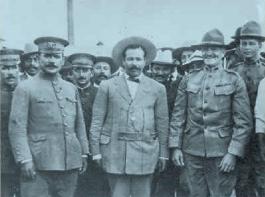
|
* How brutal was the Revolution? Look at the three smiling fellows on card [159]. The one on the right poisoned the one
in the middle, who blew off the arm of the one on the left, who riddled the auto of the one in the middle with dum dums.
(1914 photo of Generals Obregón, Villa, and Pershing. Also visible are “The Butcher” Fierro [158] and
Lt. George S. Patton [046].)
|
Location. Pax Porfiriana is located in 3 districts (see the map on the back of the box). The U.S. portion is the Gadsden Purchase,
a strip of borderland purchased from Santa Anna in 1854. The Mexican portion includes the two bordering states of Sonora and
Chihuahua. During the Pax Porfiriana American rails to Sonora and Chihuahua increased trade 900% [113]. But they remained
physically isolated from Mexico City, and separated from each other, by the generally trackless Sierra Madre mountain range.
By 1910 these two states, “so far from God and so close to the United States”, became the catalyst for revolution and putsch.
Like Boston in 1776, Paris in 1789, or Petrograd in 1917, the revolutionary guns, leaders, battles, and ideology would mostly
pivot around a small corner of the nation.
Scale. The game begins about 1898. Each round of turns is one year, so a typical game lasts until 1920, the year of Obregón’s
coup against Carranza ending the Revolution. Each Income Cube is 50,000 pesos/year and each gold piece is 50,000 pesos
(approx the same in dollars). Each Income Cube on a ranch is 60,000 Ha (~148,000 acres). Each gold spent building a Rail
Connection lays 20 km of track in desert terrain (factoring in the $12,500/km Díaz rail subsidy). Each Troop contains 1000 men.
Troops and Regimes
Makers vs. Takers. The Pax Porfiriana game theory distinguishes between businessmen, those who produce products and
services for customers, and troops, those who seize that which the makers produce. The latter includes politicians as well as
bandidos and thieves, since taxation is another form of non-productive seizure by force of arms. Troops depend on their supply
lines, and all supply lines lead to the enterprises of the productive businessmen (i.e. farmers, employees, tycoons, anyone who
earns their living by persuasion rather than force). Even U.S. troops funded from Washington cannot afford to remain over
protracted periods in an area with no U.S. interests, i.e. enterprises. Troops cannot themselves run enterprises, but only leech
off of them, as the very nature of physical force precludes it from being productive. Thus the simplified game mechanism: each
enterprise can support one troop.
Pax Porfiriana Regime [216]. A regime (aka government) is the institution with a monopoly of the use of force in a region. The
Díaz regime was enforced by the game’s green troops, notably the Rurales, elite cavalry reporting directly to Mexico City. They
counterbalanced local forces commanded by ambitious State Governors. The Rurales recruited from economically displaced
peasants and workers, numbered only 2400 men. They moved in quickly to suppress dissatisfaction with land law policies, tax
revolts, escaped slaves, and labor unrest. By 1905, 80% of the Rurales were deployed at factories to break strikes. The most
notorious of the Rurales commanders was Emilio Kosterlitsky [180], a deserter from the Czar’s Navy. His spy network kidnapped
anti-Díaz dissidents from America to be executed in Mexico [162]. Defeated in the Huerista defense of Nogales, he escaped to
Arizona and joined U.S. Intelligence [161].
Anarchy Regime [219]. Even the most chaotic region has a regime. With the scattering of local or federal troops, the
neighborhood gang becomes the new regime. The pivotal question is: what philosophy does the regime follow? The chief
anarchist intellectuals for the Revolution were the brothers Magón [003, 010]. Following their 1904 exile they were arrested by
U.S. Attorneys [144] for various imaginary charges and died in prison. In 1911, Baja California briefly fell to their followers, the
Magonistas [006]. The revolutionary communes in Baja followed the ideas of the anarchist Kropotkin. Other collectivist and
socialist intellectuals in Mexico included Jack Reed [031] (protagonist in the Warren Beatty movie “Reds”), and Manabendra
Nath Roy [043].
Martial Law Regime [218]. Ultimately the only way to change a regime is by the actual or implied use of force. Direct military
control of a region, without separation of the Executive, Legislative, and Judicial branches of government, is called martial law.
During the 1910 Revolution, State Governors could defy Mexico City and enforce martial law because the local gubernatorial
forces outnumbered the thinly-spread Federal troops.
U.S. Intervention Regime [217]. In 1910 Taft deployed almost 30,000 troops and warships to the border, giving revolutionaries
good reason to fear the possibility of invasion from the U.S., a budding world power. U.S. troops occupied Veracruz in 1914
[109] and Chihuahua in 1916 [172]. Although General Pershing of the “Punitive Expedition” reported that initial hostility was
quickly transformed into active collaboration, both of these occupations triggered unexpected resistance and public reprisals
against U.S. citizens residing in Mexico, many of whom abandoned their properties.
Occupation of Mexico had ample precedents. The McKinley administration had annexed Hawaii and the Philippines [207], and
the 1903 Platt Amendment gave the U.S. considerable influence in Cuba following the Spanish-American War [122]. Theodore
Roosevelt [215] promoted intervention in Mexico as he had in Panama [108], and had the Revolution occurred during his
1901-1909 Presidency, or had the Bull Moose Party swept the 1912 elections, Mexico might today be a U.S. Protectorate [207].
A smaller scale intervention with great inflammatory impact was the use of the Arizona Rangers to break the 1906 strike in
Cananea [198]. Mine-owner William Greene [067] called for help after fruitlessly addressing the strikers, who were demanding
pay raises and racist quotas favoring Mexicans. The mines were linked to Arizona by railroad and so the Arizona Rangers were
on the scene first. When Kosterlitsky’s Rurales [180] arrived by wagon road 3 days later, they reportedly executed and deported
hundreds of strikers. The U.S. Cavalry at Fort Huachuca [171] were mobilized to the border but did not enter Mexico on Taft’s
orders.
Slavery. Although much softer definitions are in vogue today, a slave is one who is under physical force to live for the sake of
another. A sweatshop laborer is not a slave. An employee who works for his own betterment and who is free to quit if he finds
no advantage to the arrangement cannot be compared to the enslaved Yaqui peoples. In Porfirian Sonora there was no
pretense of freedom. Escapees attempting to reach freedom in the U.S. were returned in chains or shot by the Rurales [162].
The descendants of the lucky escapees have formed their own tribe in the city of Tucson, Arizona.
Yaqui Wars. How did slavery, outlawed in Mexico since 1829, continue into the twentieth century? The Yaquis, fighting the
Spanish since 1533, were the last unsubjugated natives in the Americas, with an independent republic centered on the fortress
of El Añil in the Río Yaqui valley. It successfully repulsed the Federales until 1886, with the successful siege by state forces
armed with German repeating Mausers. A year later, the Yaqui leader Cajeme [192] was captured through treachery and
executed, yet his warriors fought on in guerrilla actions and uprisings [190]. The nefarious Governor Ysábel [184] responded in
1903 by sponsoring and personally leading “organized manhunts” [175] which sold 8000 to 15000 Yaqui of all ages into slavery
in Sonoran Plantations or in the henequen fields of Yucatán [105]. The irrepressible Yaqui were almost totally vanquished when
the Revolution breathed new life into their cause [189]. In 1915 Chief Felipe Bachomo led 2000 Yaqui warriors against the
plantations [064] and liberated most of the slaves. Medieval torture devices were found in Ysábel’s own slave hacienda at La
Europa [073]. Yaqui resistance was still active in 1926 with the kidnapping of President Obregón, who was passing through
Yaqui country by train.
Kenneth Turner’s Barbarous Mexico and James Creelman’s Diaz: Master of Mexico are two American books written just before
the apocalypse. One is a paean to Díaz “the greatest man of the American continent...an incarnation of power and courage”
the other calls him a “cowardly tyrant”, can you tell which is which? The first is a sort of Uncle Tom’s Cabin,
and the other says the Yaquis (the entire tribe!) should be called prisoners of war, and that the slave-owners are really nice to their wards.
Quoting from page 417 of the Creelman book:
“The Mexican people are too busy to fight each other now. They know that the influence
of the railways alone has not only made commerce and industry possible, but that the wages of agricultural labor have
practically doubled since Diaz gave the signal for a general railway development in the republic. They also know that even the
humblest businessman can borrow money at rates undreamed of in the old days of imaginative democracy and anarchy. Life
and property are safe. The poorest peon understands that what he can earn he can keep. The vast system of hospitals, asylums,
libraries, museums, and schools daily preach the gospel of peace.”
Ironically, Creelman himself can be said to have toppled Díaz. In an 1908 interview, Creelman reported that Díaz would not run
for re-election [204], and would open up Mexico to free elections in 1910. There was enthusiastic public response, and Madero immediately applied.
Díaz recanted and had Madero imprisoned [209], but it was too late. Alea iacta est.
Enterprises
Land Ownership. Despite the rising of the influential hacendados and the urban middle class, 85% of
the Sonoran and Chihuahuan population were subsistence farmers and herdsmen dependant on the
land. Organized under caudillos (warlords), these campesinos had defended with their blood these
lands against the incursions of Apache [134] and Yaqui Indians. A person who defends and improves
property has a legitimate claim on the values it produces. Yet the Díaz regime regarded them as
squatters on public lands. Municipal Land Laws [110] empowered federal surveying monopolies to
seize and sell baldíos (unregistered village lands) [037, 038]. The surveyors kept a third of the
proceeds, the remainder of the booty going to higher officials. By 1910, 75% of the cultivable land was
dominated by mega-haciendas. Among the gringo hacendados who acquired cheap property this way
included William Randolph Hearst [052], Teddy Roosevelt [099], and the official spokesman for
Americans in Mexico, Senator Albert Fall [018]. The embittered rightful owners of the land resources
demanded “Land and Liberty”.
Resources. The Native Americans had it right: one cannot objectively own land. How can one lay
claim to a forest or mountain? But one can own improvements on the land: the dwellings, roads,
fences, dams, mines, and other improvements collectively called “Enterprises” and “Connections” in
this game. And one can objectively own the resources derived from Enterprises one builds. The
Revolution and its million casualties was fought over a misunderstanding of the word “Resource”.1
A tree, ore deposit, or river is a not a resource until human technology, ingenuity, and sweat is applied
to make it useful. An example is the porphyry copper ores in the Moctezuma Copper District [081]. Lots
of low grade copper, no way to profitably extract it. The mining engineers Ricketts and Douglas [020]
spent years on their research and patents [039] and were the first to successfully extract copper with
concentrations below 3%. Similar measures taken on problem ores in the Cusi Silver District [096]
turned worthless rocks into a fortune. My point is that oil, cattle, garbanzo beans, lumber... none of
these are resources outside of the technological investments to locate, extract, process, and distribute
them. It is an act of injustice for a government to claim a land as “public” (i.e. regime-owned), because
again only improvements can be legitimately claimed, and only by the maker. Land-grabbing
government surveyors cost a million lives, and doomed Mexico into becoming a third-world nation.
Land Reform. The unfortunate “solution” to unjust Land Laws was “Land Reform”, xenophobic
nationalization of properties with a supposed egalitarian redistribution to peasants [116]. An example
found in the 1917 Constitution is the Ejido System [154], a reversion to utter feudalism. Control of the
land is seized by powerful socialist politicians, who allow the campesinos to work it in a commune. The
politicians retain all de facto ownership rights, and distribute the profits. Without individual ownership,
the industrious workers effectively support the lazy ones. In 1991, President Carlos Salinas de Gortari
eliminated the constitutional right to ejidos, citing the “low productivity” of communally owned land.
Many other schemes taking property from the productive and redistributing it to the non-productive,
represented by Black Cards [145, 146, 152, 160, and 164], were also failures.
Mexican Rail. Starting with 750 miles of railroads in the 1860’s, the Pax Porfiriana laid over 12,000
miles of track by 1900. Hoping to modernize Mexico, Díaz and Limantour subsidized the rails [112]
and in 1903 bought out the two main ones, the Mexican Central and the Mexican National. Don
Porfirio's rail network, erected by entrepreneurs for importing and exporting rather than internal
communication, ran from the Enterprises to the U.S. or to major ports such as Guaymas in Sonora. This
radial structure hampered centralized federal control and thus aided local troops and U.S. Intervention.
Connection Game Theory. The cost to deploy Troops is based upon their supply-lines. Federal or
U.S. Troops have supply lines along the rails and thus low railroad cost-to-deploy. Guerrilla fighters,
with grassroots support, are the opposite: the more remote the location, the more vulnerable it is to
guerrilla attack.
Copper Skyrocket. The archetype rags-to-riches-to rags mining and ranching entrepreneur in
Mexico was William Greene, the “Copper Skyrocket”. The copper reserves in Cananea had been mined
many times, but the Greene Consolidated Copper Company [086] attracted investors and brought
modern methods to the site. At his pinnacle Greene was given ticker tape parades in New York, as
master of an empire of ranches [067], lumberyards [102], mines and rails [059] throughout Sonora and
Chihuahua. But the Skyrocket just as quickly came back to Earth, and the 1906 Cananea strike
combined with aggressive New York speculators forced Greene to sell his businesses. Greene’s story
inspired my game Lords of the Sierra Madre.
Gun Stores. The principle source of arms for the Revolution was border guns stores. Profitable
border stores launched some of Arizona’s most famous dynasties, producing such notables as Barry
Goldwater [057] and singer Linda Ronstadt [077]. It was a violation of U.S. neutrality laws to sell guns
to the Revolutionaries, so sales of Winchester rifles and .30-30 ammunition were conducted in secret
and along hidden mule trails. Germany also imported Mauser rifles [065], rail howitzers [174], and
American-purchased arms [097] in support of various regimes. The outbreak of WWI [125] meant that
gun store owners, as well as their revolutionary customers, suddenly had to compete with France,
Britain, and other buyers for scarce U.S. arms.
Sonoran Banks. In Sonora, most banks were owned by the Corral-Ysábel oligarchy [076], or the
Germans [074]. These banks remained open under Huerta, but the supplanting Carranza Regime
declared the Huerta notes invalid and raided the banks for hard money. Bank owners trying to protect
their client’s investments by shipping them to the U.S. were jailed and ransomed, and their banks
seized. The nationalized banks folded completely when the Chinese were expelled, withdrawing
$400,000 in two months.
Chihuahuan Banks. In Chihuahua, the banks were bureaucracies owned by the Creel-Terrazas
oligarchy [213]. In a classic Straw Man play, Creel staged the 1908 robbery of his own Banco Minero
[056]. 300,000 pesos were taken, and Creel had the usual suspects arrested and tortured into
confessing. The regime’s case was broken by the newspaperman Silvestre Terrazas [035], a rebellious
distant cousin to Luis Terrazas and later the villista Governor of Chihuahua.
1 “The theory of property in the soil runs thus: that a man has as much a right to soil as necessary for his
existence, and when a human being has incorporated a portion of his own strength and that which belongs to his
personality into the soil against the universe.” — Frederick Douglass agreeing with John Locke’s homesteading
principle, “Property in Soil and Property in Man”
Partners
Hacendados. Your personal card starts on its loyalist side, meaning that you are a pragmatic minion,
doing whatever the Regime says. “Pragmatic” is a polite word for unscrupulous, standing for nothing.
But sooner or later you may have to take a principled stand, represented in the game by flipping your
Hacendado Card over to a Faction Color. In Mexico this means publishing a “Plan”. Examples include
the Madero Plan of San Luis Potosí declaring the Díaz Regime invalid [209], the Zapata Plan of Ayala
installing Orozco as head of a Land Reforming government [211], and the Carranza Plan of Guadalupe
installing the 1917 Constitution [208]. Madero and Enriquez also wrote influential books, quickly
banned by the dictatorship [147].
Bureaucratic vs. Private Partners. The separation of business and state is a principle of free
enterprise. Many “businessmen” seek to set prices and production policies independent of the market,
by colluding with the regime. Such men are actually bureaucrats, and their “business” is a
bureaucracy. A heavily regulated business is also a bureaucracy. In the Pax Porfiriana, most
businessmen had their prices and quotas set by the Centro Industrial bureaucracy [149], making
Secretary of Finance Limantour [165] the effective head of their business (and receiving much of the
profits).
Mexican Oligarchies. In all of Mexico, the worst offenders of the separation of business and state
were the Corral-Ysábel oligarchy of Sonora [044], and the Terrazas-Creel oligarchy of Chihuahua [213].
These hacendados were simultaneously Governors, heads of the state bank, leaders of the state
troops, tax-collectors [140], and chief landowners [143]. They were, after Díaz, the most powerful men
in Mexico, and the most opposed to reform. Enrique Creel became son-in-law of Luis Terrazas by virtue
of marriage to his daughter Angela [017], and the Terrazas-Creel clan dominated 66 terms in the state
legislature and 22 terms in the national legislature [011]. In Chihuahuan tax disputes [139], Díaz would
sometimes side with the rebels, in order to keep the Terrazas-Creel clan from gaining too much power
[119].
Monopolies. Another much abused word. A successful businessman is not a monopolist if he
offers a new or cheaper product, even if it proves wildly popular [151]. A monopoly is an institution
that uses the force of arms to outlaw competing producers from a given field. This can be
accomplished only by an act of government intervention, in the form of subsidies, regulations, bailouts,
franchises, or tariffs. A notorious example is the Teapot Dome Scandal [018], when Senator Albert Fall
became the first U.S. cabinet member imprisoned for soliciting kickbacks from Sinclair Oil. A typical
Mexican Monopoly is the Dynamite Company run by the son of the dictator [028]. This profitable
monopoly outlawed internal competition, and subjected dynamite imports to stiff tariffs.
Catholic Church. To his credit, Díaz practiced the separation of church and state: “As Porfirio Díaz, in
private and as head of a family, I am a Roman and Apostolic Catholic; as Head of State I profess no
religion, because the law does not permit me to do so.” [120]. The “distinguished and faithful” friend of
Díaz, Archbishop Gillow, established Catholic Labor Groups inspired by the papal Rerum Novarum
[126]. The “Red Church” soured when the Freemason and Revolutionary governor of Sonora, Plutarco
Elías Calles, gained control control of the Presidency. and sought to seize Church properties. During
the anti-Calles resistance known as the Cristeros War [199], priests went on strike, refusing to
administer the mass or give absolution for the dead, and declaring it a sin [130] to join Red Labor
groups such as CROM [029]. Thousands of priests were shot [202], and about 90,000 died in the
fighting. I have simulated the omnipresent yet two-faced nature of the Church in Mexico by making it a
bi-color red-white Public Card [214].
Labor and Unions
The labor movement entered the 20th century split into two warring camps: the
anarcho-syndicalists (striker cards conferring a Revolution Point) and the conservatives (striker cards
conferring an Outrage Point). The former, such as the IWW “Wobblys” and the WFM [004], aimed to
abolish capitalism and the wage system, while the latter, such as the AFL led by the ex-Socialist Sam
Gompers [141], sought to advance labor interests while accommodating capitalism. Gompers
cooperated with widespread regime arrests and deportations of anarcho-syndicalists members [123],
who were all but defunct by 1920.
The Mexican anarcho-syndicalists [197] recruited urban workers into Red Battalions [002], fighting
alongside Constitutionalist Armies. Paradoxically, The Reds fought against rural peasants of similar
ideology such as Zapatistas. In 1916 Carranza disbanded the Red Battalions and forcibly closed down
the syndicates. The conservative alternative to the radical unions was the CROM, led by Luis Napoleón
Morones [029]. Corones, allied to Gompers [142], led a lavish lifestyle full of flashy cars, women, and
jewels.
Ultimately the anarcho-syndicalists failed because their ideas are objectively wrong. The Wobbly
manifesto [005] stated “the working class and the employing class have nothing in common”, a false
dichotomy. In reality, all employees are businessmen. From the janitor to the CEO, each cooperatively
works for his own benefit, on the trader principle (e.g. work for pay). A person deserves from another
that and only that which he earns. A syndicalist cooperative, paying every employee the same
regardless of what he does, violates the trader principle and rewards the unproductive at the expense
of the productive.
Headlines and Economy
Halley’s Comet. It is a Sierra Madre Games tradition to have a comet appear in every game [128]. In
1910 astronomers announced that Earth would actually pass through Halley’s tail during May of that
year. Unscrupulous doomsayers asserted that since comets contain cyanide gases that all of humanity
was at risk. Some newspapers ran with this story, shysters sold “comet pills” said to counteract the
poison, and the resulting minor panic may have helped push Mexico over the edge.
Costs of Local vs. Federal Government. Examination of the financial reports of New Mexico and
Arizona before and after statehood in 1912 supports claims that statehood allows the federal regime to
use its greater sovereignty to impose more taxes. The ratios of receipts and expenditures to property
values and the U.S. GNP show that the cost of government rose far more in the two new states than in
a control state, Nevada. This cost is reflected in the Arizona Statehood Headline [106].
Depression. New ideas and technologies make products and services cheaper and more accessible
[036]. Falling prices are a sign of progress and health. What wipes out profits and makes debt
repayment more difficult is not falling prices but monetary contraction, i.e., the reduction in the
volume of spending in the economic system following the expansion of the supply of fiduciary media
relative to the supply of gold. In 1902, Secretary of the Treasury L. M. Shaw instituted a central bank
[117, 118], a bureaucracy capable of printing fiat money in case there is a bank run and people want
their property (money) back. This idea, opposed by those who support hard money on the gold
standard, was to provide an elastic currency through regime control of the money supply. It allowed
commercial banks to expand their supply of credit without risk, and led to monetary contraction and
the Panic of 1907.
Panic of 1907. The 1907 Panic was the most serious that Porfirian Mexico ever suffered, felt most
keenly in the northern states, the economies of which were closely linked to the United States.
Exacerbated by droughts in 1908 and 1909, the price of food rose 200%. Middle classes were
particularly hit hard, and small enterprises went bankrupt. The cost of money rose to 18 to 24% for
private moneylenders. The price of silver and copper plummeted, and the mining tycoons Greene
[067, 086, 102] and the Guggenheims [079, 081] shut down operations in Mexico. The U.S. proclaimed
the first ever ban on Mexican Immigration, and more than 2000 Mexicans were given railway tickets for
deportation into Chihuahua.
Federal Reserve. In 1913 the U.S. took another step in the demonetization of gold with passage of
the Federal Reserve [118]. This set up a government-backed central banking system for the pooling of
emergency funds, and reduced not only the necessary legal reserves held at the Federal Reserve
Banks (increasing the multiplier by which banks could expand the money supply through loans), but
also the vault cash requirements. The Federal Reserve aggressively expanded the money supply in the
belief that printing “elastic” money could contribute to prosperity and support the British pound in
foreign exchange markets. From 1923 to 1927, $548 million in Federal Reserve Credit was forced into
the banking system. The problem is that bureaucrats can print all the money they wish, but they are
takers and only makers can give money value. The “elastic money” system crashed in 1928. Yet it has
remained popular among politicians, allowing them to print their way out of debt, at the expense of
every citizen with a savings account. In 1993 and 1999 Congress passed acts designed to allow
persons with limited finances to get housing. The heavily-regulated banking industry, backed by
government funny money, crashed in 2009.
The Revolution
The Fall of Díaz and Madero. The Maderista leaders Villa, Orozco, and Zapata toppled Díaz in
1911. But when the new regime failed to redistribute land or break up the Porfirian command
structure, the disgusted revolutionaries both left and right turned on him. A right wing coup led by
General Huerta [215] and Bernardo Reyes [211], and backed by the U.S. Consul Henry Lane Wilson
[163] deposed and executed Madero in the Decena Trágica [155].
Revolutionary Regimes. The Decena Trágica returned Mexico to the Porfiriana, but without the Pax.
Sonora and Chihuahua became a battleground for “The Big Four” personalities of the post-Madero
Revolution: Orozco, Villa, Carranza, and Obregón:
-
The Orozquista Red-Flaggers [167] promised land reform, but Pascual Orozco [210] would prove to be a pragmatic opportunist
who never redistributed any land. Funded by cattle baron Luis Terrazas [213], he backed the Huerta coup against Madero and
a return to a neo-Porfirian Chihuahua [041]. British Oil [045] and German Intriguers [153] also supported the successful
Huerta coup. But Orozco and President Huerta were toppled and exiled in 1914, and both were arrested by the U.S. Secret Service
trying to re-enter Mexico with German backing. Both died in captivity in 1915.
-
Venustiano Carranza [208] was born and raised a hacendado, and so strongly opposed confiscating land from the upper class.
Nevertheless, he had to enact radical agrarian legislation to increase his support against his chief rival, Pancho Villa.
In 1915, President Carranza nullified all Porfirian land, water, and forest concessions [116] and placed all Mexico’s natural
resources under nation domain, clearing the way for massive nationalizations [040]. This attacked all three landowning pillars
of the Díaz regime: hacendados, foreign investors, and the Catholic Church [214]. Carranza’s Constitutionalist regime violently
resisted the U.S. Punitive Expedition [172], heavily taxed selected U.S. enterprises in Mexico, sponsored the tragic Sedonista
revolt in Texas [138], and consorted with Germans culminating in the notorious Zimmermann Telegram [121]. Despite these, Carranza
enjoyed the support of Cleveland Dodge of Phelps Dodge [098], U.S. Oil, labor leader Sam Gompers [142], and President Wilson [133].
-
Pancho Villa [177] was the most pro-American of the revolutionaries, hoping for access to U.S. arms and eventual U.S. recognition.
He scrupulously left the American Enterprises alone while mercilessly expropriating Spanish and Mexican haciendas, especially those
of the hated Terrazas-Creel clan. Many panicked hacendados sold their properties to U.S. speculators for bargain prices. With Villa’s
defeat in April 1915, these speculators divested themselves of large amounts of Villa currency acquired when it seemed that Villa
could not lose. This collapsed the Chihuahuan economy and brought soaring prices and food riots. When Villa desperately put pressure
on U.S. firms, President Wilson not only recognized the regime of Villa’s arch-rival Carranza [133], but he also helped the Carranzistas
smash Villa at Agua Prieta. After this, Villa went on a rampage against Americans [203], culminating in the infamous 1916 raid against
Columbus, New Mexico [124].
-
Alvaro Obregón [022], an impoverished but clever farmer and entrepreneur, gained Yaqui support by promising to end slavery
and distribute land to anyone who fought for him [189]. Recognizing that the modern battlefield had become dominated by defensive weapons,
he favored artillery [024], machine guns [030], and aeroplanes [033] rather than the wild cavalry charges preferred by Villa. Joining the
Revolution as a Maderista and then a Constitutionalist, Obregón eventually turned on President Carranza and had him assassinated, ending
the Mexican Revolution in 1920. As the “one-armed President” (he lost his right arm to villista artillery), he is widely
suspected of sponsoring the assassination of Pancho Villa as well.
Mexico For the Mexicans [131]. The Pax Porfiriana welcomed persons of all races and nationalities
in its development of Mexico (with the tragic exception of the Yaqui tribe). Not just Americans but low
budget immigrants such as Mormons [156] and Chinese [146] flourished in Mexico, which is why card
146 is the only victim-awarded Loyalty Point. The supplanting Revolutionary Regimes were racist, and
the Calles regime [202] even embraced fascism, deporting Jews, Chinese, and other undesirables.
Another step backwards for Mexico. Think about it. “Mexico for the Mexicans” implicitly accepts the
idea that one race can own mountains and trees, combining the mistakes of Hitler with those described
in the “resources” essay.
Legacy. The Revolution yielded a series of Communist regimes, although the fighting did not entirely
end in 1920 [191, 130, 199, 202]. By the 1930’s President Lázaro Cárdenas seized the remaining
property owned by foreigners without compensation. But bureaucrats are unsuited to run businesses
and most fell into ruin. The new Constitutionalist power block of middle-class urbanites yielded the
socialist PRI state party [181], which would win every election for the next 70 years with the help of
massive electoral fraud. Even with all its population and potential resources, Mexico would enter the
21st century resembling a banana republic [030] rather than the U.S. or Canada. Since 2000, three
journalists a year are murdered. The U.S.-Mexico border, unfenced and unpatrolled during the Pax
Porfiriana, resembles a Gulag today. Each year hundreds of brave and industrious hopefuls yearning for
work in the U.S., including perhaps Mexico’s best minds, die of thirst in the desert not so far from my
Tucson home.
The Bandidos And I. In the late 1980’s my nine-year old son Matt and I visited the giant
solar-powered aquaculture center, built by the University of Arizona [083] and Coca-Cola. A caretaker
let us into the abandoned complex near Puerto Peñasco, Sonora. The domes and tanks from my marine
biology undergrad days were empty and rusted through. Nationalized by armed Federales in the great
shrimp shutdown of June 26, 1980, Dr. Hodges’ team had evacuated that same day. As a further nasty
reminder that in Mexico one is never far from the gun, Matt and I were detained by armed men on a
lonely dirt road. An unmarked van, no uniforms, automatic rifles, autoloading pistols shoved into
waistbands without the benefit of holsters. These were extralegal Judiciales, empowered to prey on
Mexico’s own refugees attempting to escape to America.
The Meaning Of Revolution. A revolution is the climax of a clash of philosophical ideas, an outburst
of discontent that sets the course of entire peoples and cultures. The tragedy of the Mexican
Revolution is that it failed to correct the core problem of the Porfiriana, the intertwining of business and
state. In contrast to the American Revolution, it subjugated the makers to the takers. By empowering
politicians to control the means of production, it doomed Mexicans to a kind fatalistic paternalism. But
for the flaws and quirks of its principal activists and intellectuals, the events of 1910 could have
resulted in a very different Mexico today. Matt and I have reacted this struggle to investigate what
could have been.
Phil Eklund
– end of the living rules –
Rules Clarification
(this section will be expanded as necessary)
The following rules clarification has been confirmed by author Phil Eklund.
-
Swift Refrigerator Line: If this Partner is removed from play the player who had this card in his tableau must remove one connection cube
from all connection ovals that have two cubes. If there are two cubes from different players, the player must choose which cube he wants to remove.
If you have Swift Refrigerator Line in play and there is a connection with a single cube of your color, you may add a second cube to that connection for zero gold by using either
an Upgrade Connection action or a Speculation action, see this thread (BGG).
-
Orange Cards: If the play of an Orange Card would change the current regime, you may not play that card in case that Headline Event [133]
is active. Regime Change is a process and the rules state that you cannot play an Orange or Black Card if the card process cannot be performed.
It is not forbidden to play an Orange Card that depicts a “Jailed” icon against a victim that is immune from jail. (The victim is released instantly.)
-
Newspapers: If you steal a Newspaper you may change the card’s orientation when placing it in your tableau. You must pay the cost
of the orientation that you choose when placing it in your tableau.
-
Spies: Only the victim player of a Black or Orange Card can play a spy.
-
Player Assassination: During your topple turn, you may play only one Assassination Card from your hand to kill a flipped Hacendado.
-
Headlines 107 (“Klondike Gold!”) and 112 (“Díaz announces big rail subsidies”): Connection Cubes
on enterprises that suffer from unrest do not earn gold.
The User Interface
A. Summary
This implementation uses simplified card images that only show the relevant information (no history text). Click the upper right corner of such an image
to show the corresponding original card image. By default, the market is shown. Click on a player info box to show the tableau of that player. Click again
to close the tableau view (the market will be shown again). Click a card that is marked in its lower left corner to perform an action with that card.
The highlighted action info boxes below your player info box indicate which actions you can currently perform. Click the pile info box (side panel) to show
the cards in a pile.
There is an FAQ section answering the most frequently asked questions about the implementation.
B. Anatomy
Overview
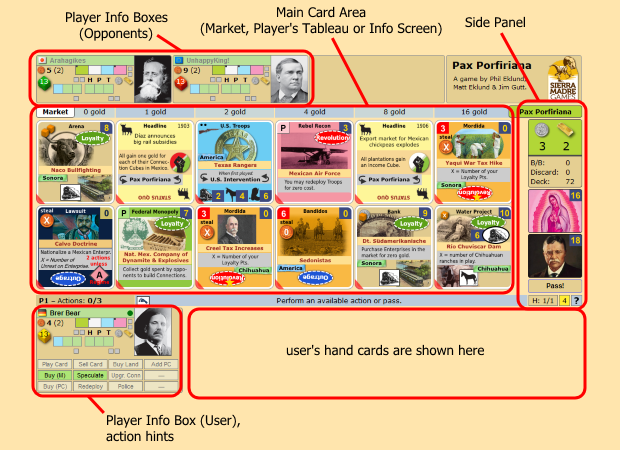
Player Info Box

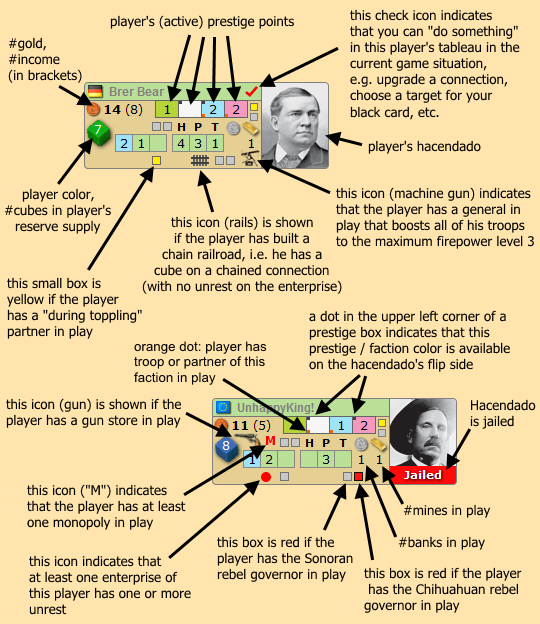
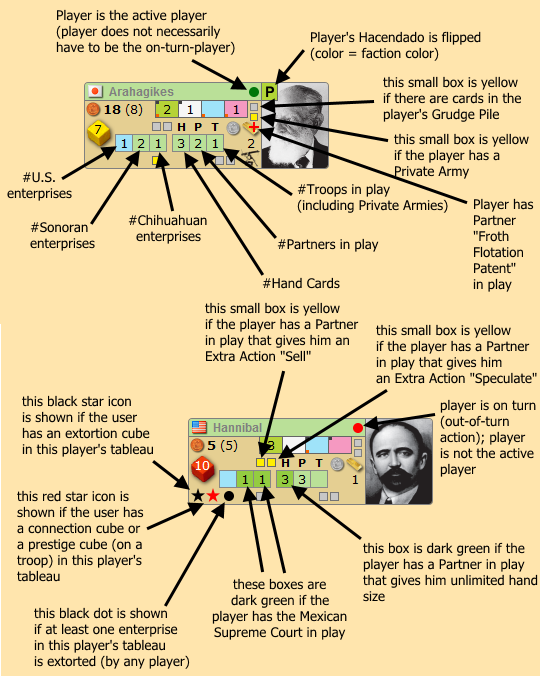
Action Hints
The user’s own player info is shown inside an extended panel that also contains hints about whether an action can be performed or not.
There are also a few additional info boxes, e.g. one that is shown if the user has a partner in play that allows him to purchase Orange Cards for
zero gold. All action hints are only shown/highlighted in the standard game situation (“perform an action”) or if a card action menu is shown.
Possible clicks:
None except the standard player info clicks (show/hide player’s tableau, show player’s Hacendado Card).
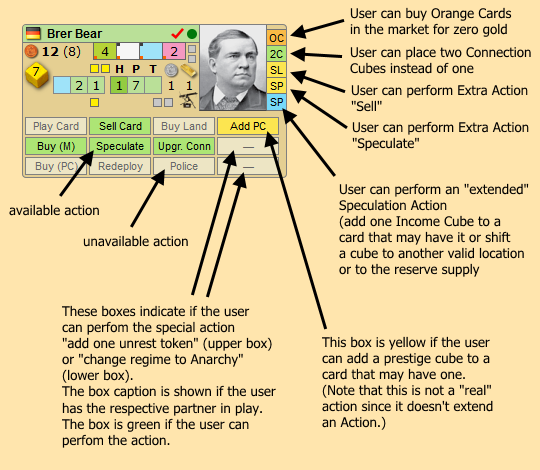
Example: The “Upgrade Connection” box is highlighted which means that you can currently perform that action. (There is
at least one suitable enterprise somewhere that has an unoccupied connection oval, you have enough gold to pay the cost, and you have at least one
cube in your reserve supply.) It doesn’t exactly tell you where to find a suitable enterprise, though: it could be in your own tableau or in
your opponent’s tableau, although if a player’s check icon is not shown, then you know that there is no such enterprise in that
player’s tableau.
Service Button
There are a few game situations where the action hints below your player info are hidden and a button is shown instead (see example below).
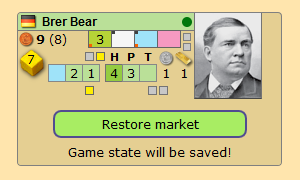
Possible game situations:
-
Speculation: Cube Management (click button to add the chosen cube to your reserves)
-
“Pay-for-your-cards” events (click button to pay the cost)
-
Retreat (click button to show/hide retreat screen)
-
Topple Attempt (click button to finish your topple turn)
-
Restore Market (click button to restore the market)
-
Pay depression cost (click button to pay the cost)
Side Panel
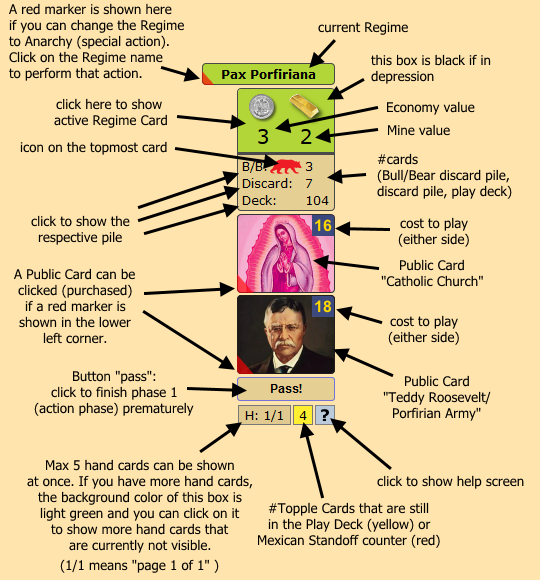
The side panel offers the following features:
-
show the current regime
-
perform action: change Regime to Anarchy
-
show the current regime’s Mine value & Economy value
-
show if there is a depression
-
show the number of cards in the piles (Bull/Bear discard pile, discard pile, play deck)
-
show the topmost card’s icon (Bull/Bear discard pile)
-
perform action: purchase a Public Card
-
Pass (action phase)
-
switch visible hand cards (if # hand cards > 5)
-
show number of Topple Cards in the draw pile (play deck)
-
show Game Help
Possible clicks:
-
click on the regime name to change the regime to Anarchy (action must be available)
-
click on the Mine/Economy info box below the regime name to show the active Regime Card
-
click on the Pile info box to open/close the pile view
-
click on a Public Card symbol to purchase and play that card (action must be available)
-
click on the Pass button to finish phase 1 (action phase)
-
click on the Hand page info to show more hand cards that are currently not shown
-
click on the Help icon to show/hide the help screen
Tableau View
By default, the market is shown. Click on a player info box to show the corresponding tableau (or hide it if that tableau view is already active).
The Hacendado is shown in all card areas (except hand) at the top left of the screen (at first position). As always, you can click the upper right
corner of a card to show the corresponding original card image.
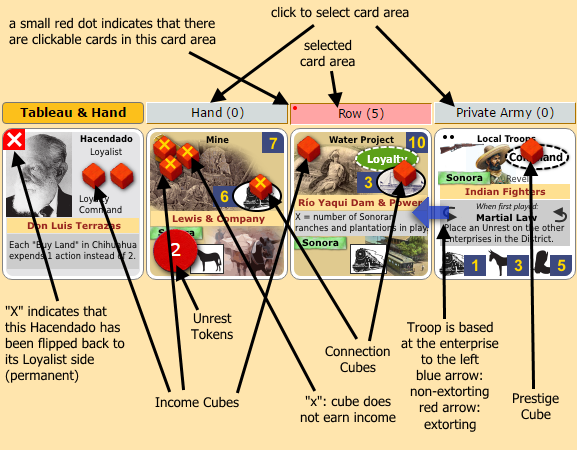
Pile View
The cards in the play deck are of course hidden (unless it is a history game), but the system will show you the Topple Cards that have not yet been drawn,
sorted by card number. Other than that, the layout of the pile screen should be straightforward (see illustration below). The top card is always
shown at the top left of the screen on page 1.
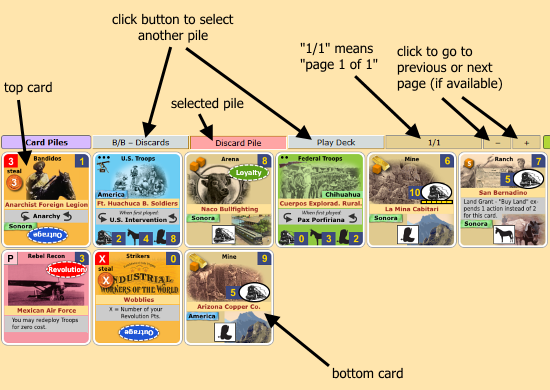
Card View
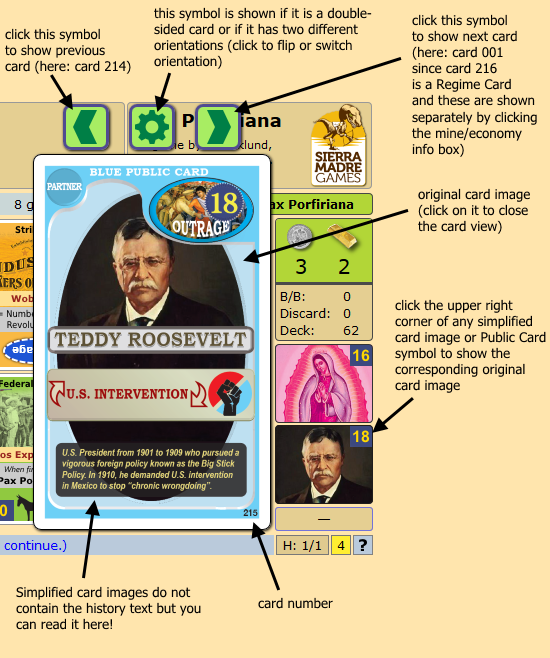
Game Log
Click the “foot” icon above your player info box to open the game log (see image below). The log entries
themselves should be self-explanatory. Whenever you perform an action during your turn, the corresponding log entry will be added
immediately.
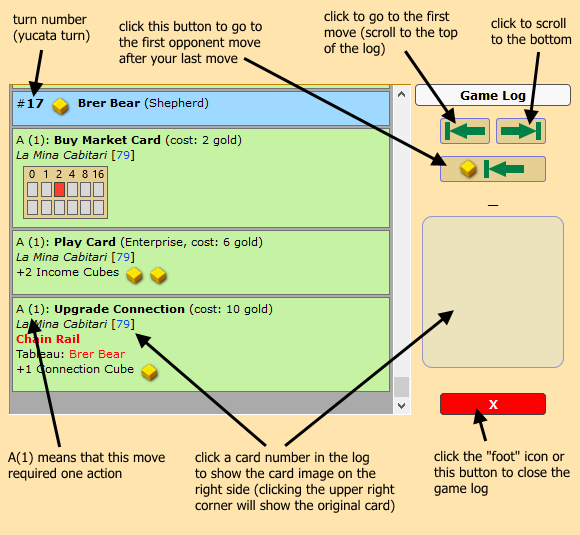
|
On the right side of the log screen you will find a secondary log (see image right). Whenever an important event occurs that directly
affects you, an entry will be added here. These entries only provide a short description of what happened. Have a look at the main log for
details. A red exclamation mark next to the foot icon indicates that event entries exist. The sign will be removed when you open the
game log. All entries in the event log are deleted at the end of your turn. (The system has to assume that you took note of the entries.)
The following activities trigger a new entry in the event log:
-
an enterprise of yours gets lost (by nationalization, sacking, etc.)
-
a partner of yours has been stolen
-
a partner of yours has been assassinated
-
a troop of yours has automatically retreated
-
a troop of yours has automatically been discarded
-
your Hacendado has been assassinated
-
your Hacendado has been jailed
-
you received a victim-awarded card
-
you received gold (Speculation Cube)
-
you received gold (Monopoly)
-
you received gold (Gun Store)
-
an opponent has stolen your gold
-
Half of your gold has been discarded (event)
-
a Monopoly of yours has been discarded (event)
-
an enterprise of yours is extorted
-
Unrest Disks have been added to an enterprise of yours
-
a Rebel Governor has been played
-
a Connection Cube of yours has been removed (Black Card “Mormon Lumber” [156])
-
an opponent puts a Connection Cube onto an enterprise of yours (i.e. he upgrades the connection)
-
the income of an opponent’s Smelter/Project has been increased when you played an enterprise that
supports it.
|
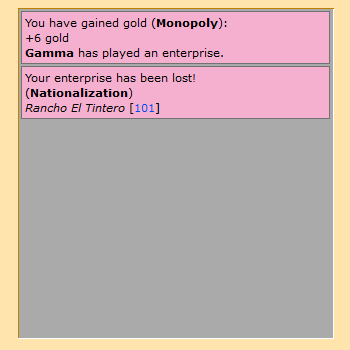
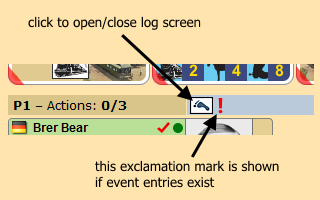
|
C. How to perform actions
Normally, you click a card to perform an action with that card. If a card is not highlighted, it means that you cannot perform
an action with that card at this point in time. Clicking the card will open the card menu where you can select a suitable action (only available
actions are listed in the menu).
There are two exceptions:
-
Action “Change Regime to Anarchy”: click the regime name in the side panel area to perform this action
-
Action “Buy Public Card”: click on a Public Card icon in the side panel area to purchase that card
Cubes are usually placed and removed automatically and there are no fancy animations or the like.
Have a look at the game log to see if cubes have been added or removed as expected.
Example 1:
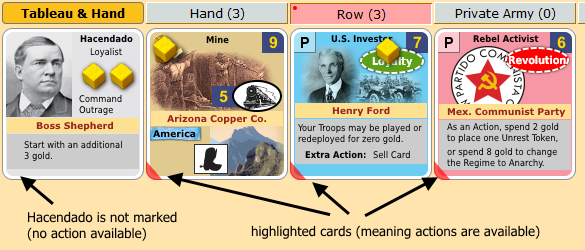
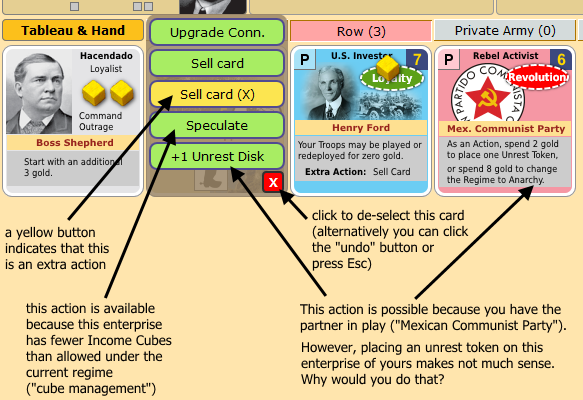
Example 2:
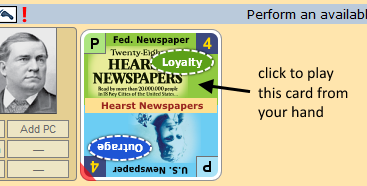
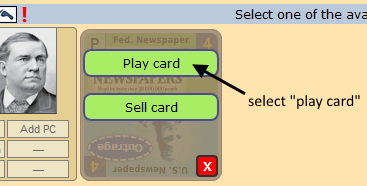
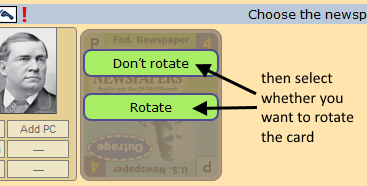
D. Game Screens & User Interaction
We distinguish between 3 types of game screens:
-
Card View Screen (an original card image is shown)
-
Info Screen (one of the following screens is active, card view is inactive)
-
Log Screen
-
Pile Screen
-
Help Screen
-
Standard Screen (neither the card view screen nor any info screen is active)
If the Card View Screen is active, you can only...
-
close the card view screen (click on the original card image)
-
show another original card (click the upper right corner of a simplified card image)
If any Info Screen is active, you can only...
-
close the info screen
-
open another info screen
-
show an original card (click the upper right corner of a simplified card image)
If the Standard Screen is active, you can...
-
if it is your turn: perform actions
-
open any info screen
-
show an original card (click the upper right corner of a simplified card image)
Note: On the start screen you can only select colors and start your turn, all other clicks are inactive.
E. Frequently Asked Questions (User Interface)
-
I need to flip my Hacendado during a Topple event and the option is not presented or I cannot find it. Bug?
“Flip H” is just meant as a hint that this Topple action is available. To flip your Hacendado
to its “Partner” side, open your tableau and click your Hacendado card, then choose the orientation.
-
Economy is depression. The game informs me that I have to pay 1 gold or discard a card in play.
I have no money and no cards to lose so the game is not allowing me to continue. I am stuck.
Open your tableau and click the “Private Army” button to check if there is a troop card you overlooked.
Also check the other players’ tableaux. There might be an extorting troop of yours you overlooked.
F. Credit
The Mexican flag that is shown on the start screen has been created by developer Brer Bear. It is based on an image from Wikimedia Commons
(license information below).
TownDown, Wikimedia Commons, License: CC BY-SA 3.0
| |